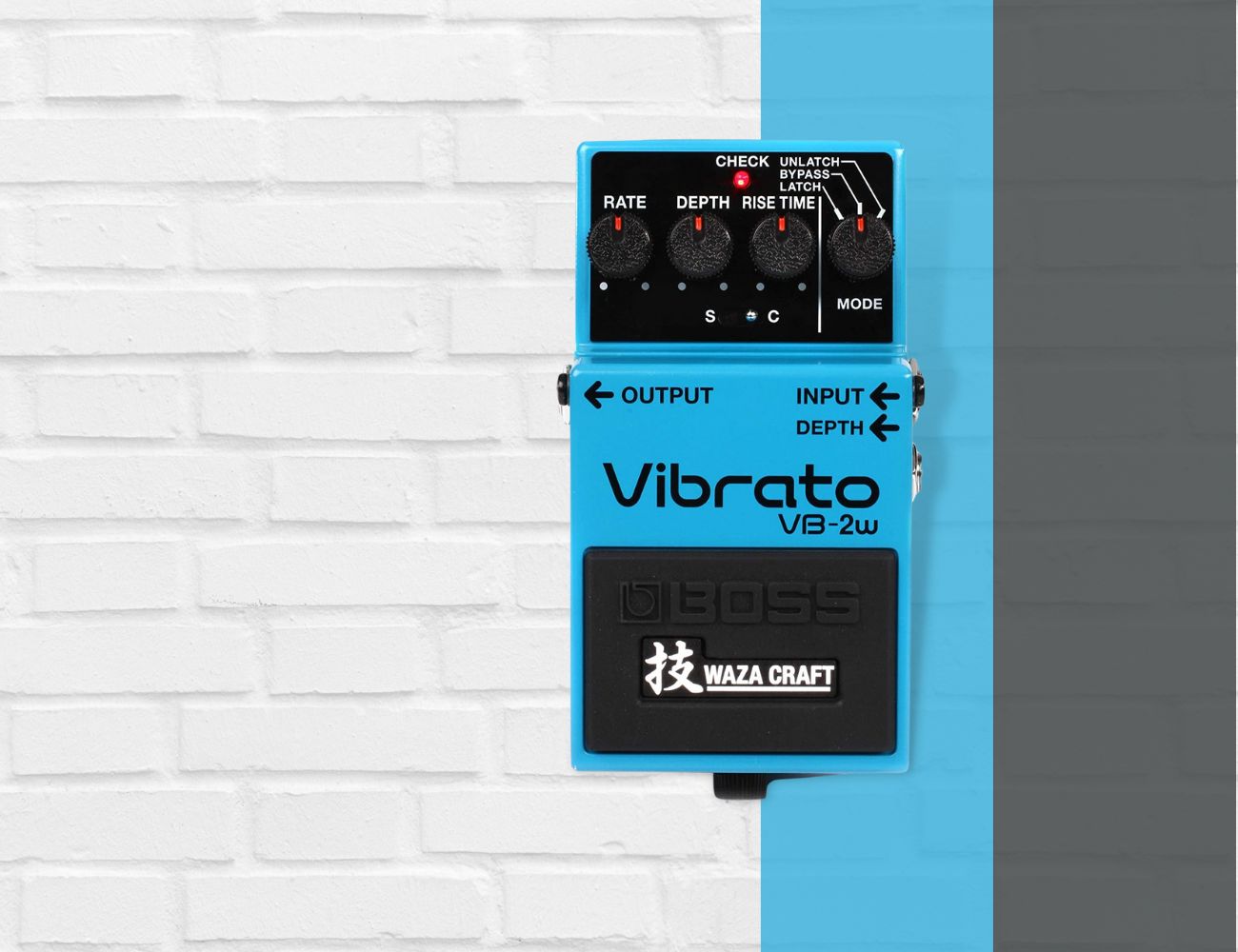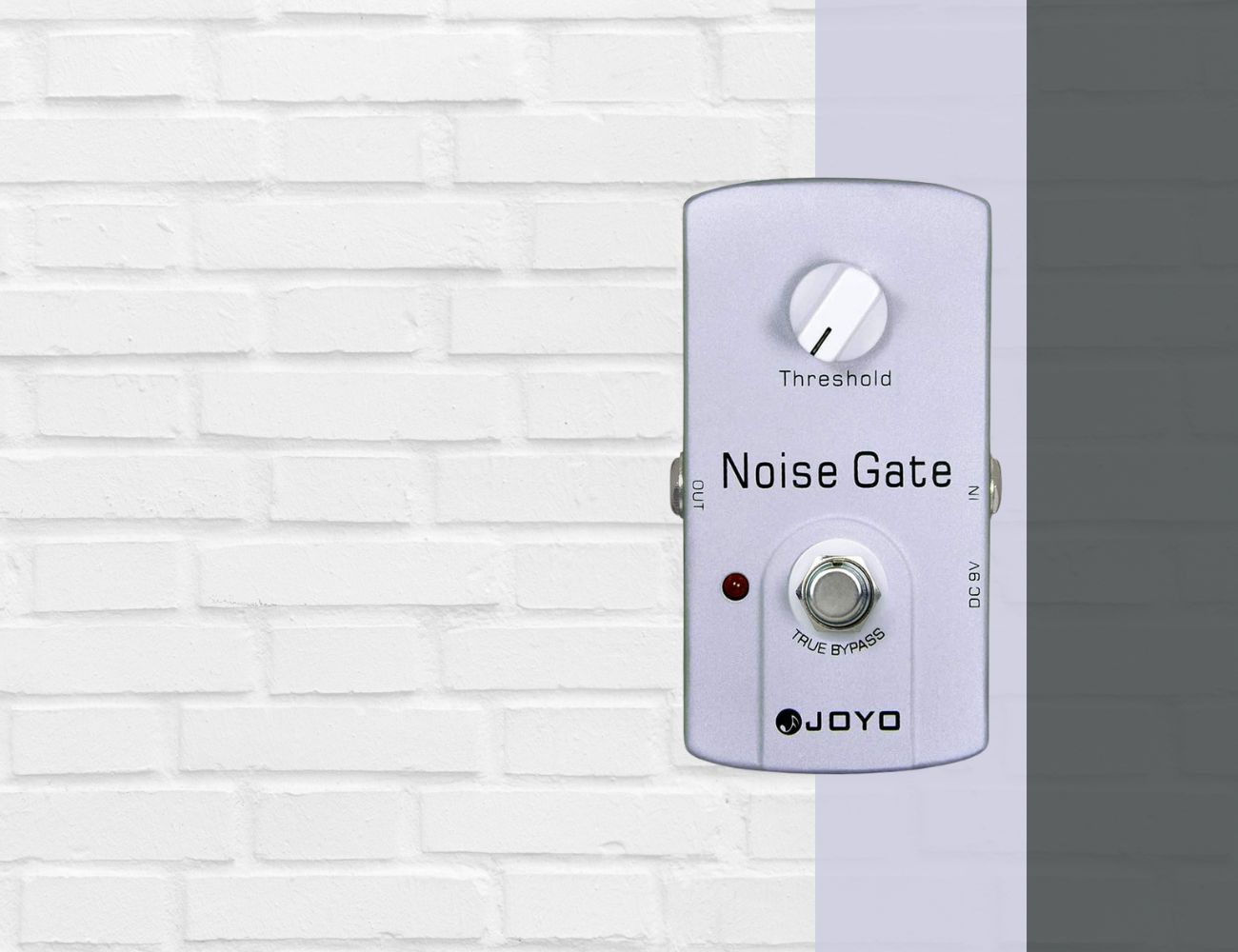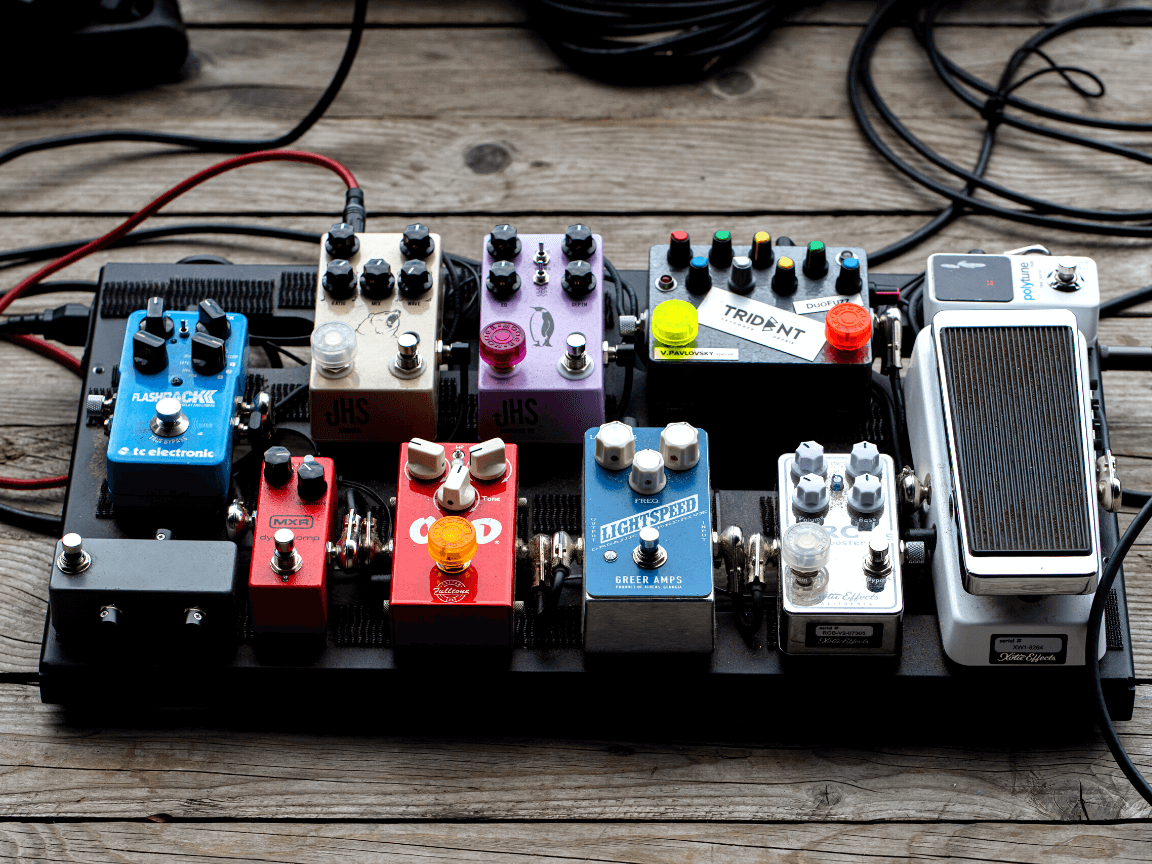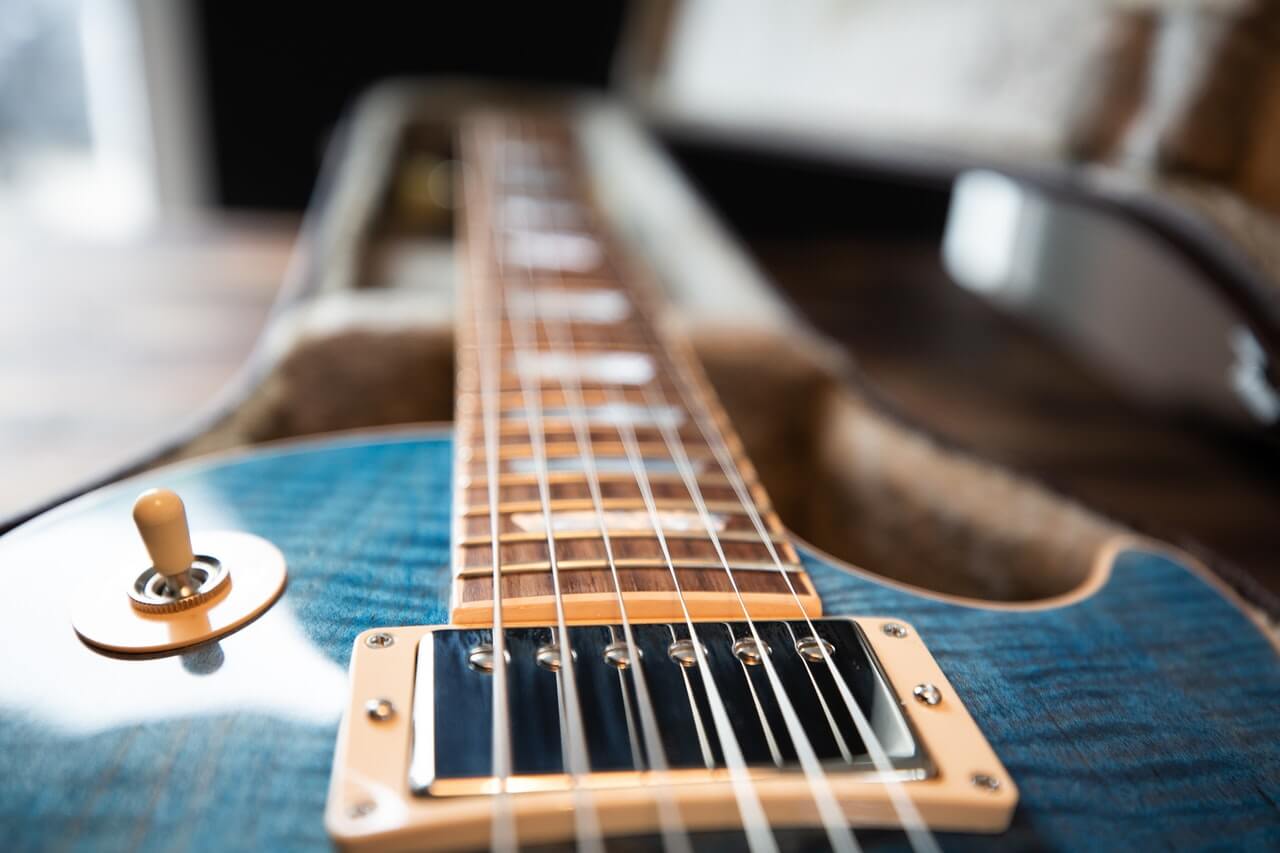Are you searching for the perfect pitch-wobbling magic to elevate your guitar sound? The best vibrato pedals can make that dream come true, giving your guitar tones an enchanting spin that lures the listener.
But, with many options on the market, identifying the ideal choice can feel like searching for a needle in a haystack.
Fear not! In this article, we will navigate the wide sea of vibrato pedals, highlighting the best to make your quest a breeze.
We’ll delve into their unique features, why they’re top-rated, and what makes them resonate with guitarists around the globe.
This is your express guide to achieving the expressive and pulsating tones that make an unforgettable musical experience.
Let’s dive into the world of vibrato pedals and unlock their potential to revolutionize your music!
Table of Contents
- Best Vibrato Pedals
- ZVEX Instant Lo-Fi Junky Chorus Vibrato Guitar Pedal
- EarthQuaker Devices Aqueduct Vibrato Pedal
- Boss VB-2W Waza Craft Vibrato Pedal
- Caroline Guitar Somersault Vibrato Pedal
- Fender Bubbler Analog Chorus/Vibrato Pedal
- Walrus Audio Julianna Deluxe Chorus Vibrato Pedal
- Jackson Audio New Wave Vibrato Pedal
- Dunlop Authentic Jimi Hendrix ’68 Vibrato Pedal
- DigiTech Ventura Vibe Vibrato Pedal
- MXR M-68 Vibrato Pedal
- Keeley Seafoam Plus Vibrato Chorus Pedal
- Caline Mini Guitar Vibrato Pedal
- JAM Pedals Ripply Fall RetroVibe Vibrato Pedal
- TC Electronic SHAKER Mini Vibrato Pedal
- Caline CP-506 Multimod Guitar Pedal
- TC Electronic TAILSPIN Vibrato Pedal
- FLAMMA FC05 Mini Modulation Pedal
- What exactly is a vibrato pedal?
- What should you consider when choosing a vibrato pedal?
- How to properly use a vibrato pedal?
- How to order pedals on a pedalboard?
- Boutique vs. Mass-Produced pedals
- How much should you spend on a guitar pedal?
- Can you use a guitar pedal with a bass guitar?
- How to properly power your pedals?
Best Vibrato Pedals
Before I begin, here are my top selected choices:
Boss VB-2W Waza Craft Vibrato Pedal

Real-time control, vintage and custom vibrato settings with Waza Craft VB-2W. Check Price
|
|
FLAMMA FC05 Mini Modulation Pedal

Compact, durable, 11 effects modes for creative sound. Check Price
|
ZVEX Instant Lo-Fi Junky Chorus Vibrato Guitar Pedal
Create unique, haunting chorus and vibrato sounds.
This Vexter series pedal allows you to mix your crystal-clear, compressed sound with a warbled, lo-fi signal for unique, haunting chorus and vibrato sounds. All Vexters feature the same quality parts as hand-painted pedals at a lower price.
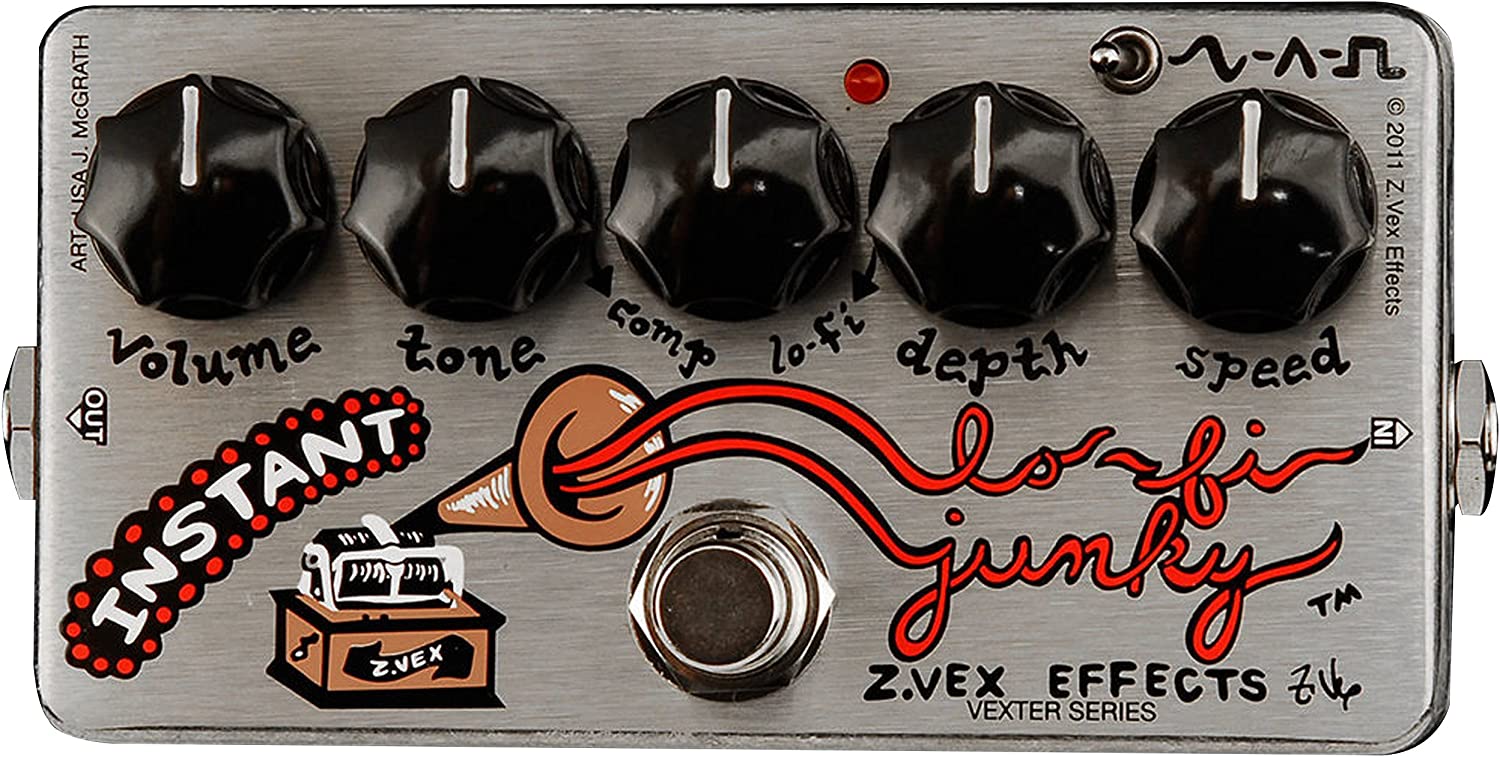
Meet the distinctive ZVEX Vexter Series Lo-Fi Junky, a unique modulation, chorus, and vibrato effect blend in one sleek guitar pedal.
This inventive device is more than a recreation of the original Lo-Fi Loop Junky; it also introduces fresh, unheard-of auditory experiences.
Crafted with a mix of THAT chip compression, Belling bucket brigades, and ultra-low current National Semiconductor op-amp filters, it superbly reproduces its predecessor’s nuanced texture and vibe, all packed into an incredible new box.
The magic of the Lo-Fi Junky is its duality.
On the one hand, your guitar’s clear, compressed signal remains sparkly and intact; simultaneously, the crushed, low-fidelity warbled signal creates a harmonious blend that can be mixed to the desired depth.
The result is a rich chorus soundscape and a pulsating vibrato that’s hauntingly beautiful.
Stylized with silk-screened art, Vexter Series pedals don’t compromise on quality.
This pedal offers endless sonic possibilities, especially for those craving an obscurer, filtered sound.
- My Review
From the first riff, it’s clear that the ZVEX Vexter Series Lo-Fi Junky is more than meets the eye.
This pedal is a chameleon of sound, offering a range from shimmering clarity to gritty lo-fi.
Its epic chorus and vibrato effects, achieved by mixing a clean compressed signal with a warbled lo-fi one, are akin to fine-tuning a masterpiece.
Dialing down the lo-fi mode, I was transported back to the classic rock era with a distinctly gritty, Steppenwolf or Jimmy Page-esque tone.
I could feel this pedal’s raw power and texture, especially when the vibrato was subtly fired up.
Twisting the knobs a bit more, I found myself in a melancholic soundscape that sagged with emotion.
There’s something beautifully haunting about the mix of chorus and vibrato on this pedal.
Conversely, using the pedal in a live setting was a different experience.
The nuances that felt so powerful during the studio session were somewhat lost at higher volumes, resulting in an overwhelming sound for a humbucker-loaded guitar.
However, the pedal shines in a low to mid-gain setting.
The combination of compression, lo-fi, and vibrato creates a sonic texture that’s distinctive and compelling, particularly when exploring jazz chords or more experimental sounds.
One thing to note is the need for a power supply or 9V batteries.
Running out of juice midway through a gig is not something any guitarist wants to experience, so make sure you’re prepared.
While the ZVEX Vexter Series Lo-Fi Junky may not be for everyone, it offers an extraordinary range of possibilities for creating unique tones.
Whether in a studio, jamming at home, or rocking out on stage, its versatility makes it a solid addition to any pedalboard.
Here are the ratings I’ll give to the ZVEX Instant Lo-Fi Junky Chorus Vibrato Guitar Pedal:
- Pros:
- Offers a wide range of sounds.
- Easy to blend clean and lo-fi signals.
- Excellent for studio and low to mid gain settings.
- Cons:
- Sound can be overwhelming at higher volumes.
- Requires power supply or 9V batteries.
- May not be suitable for all music genres.
My final verdict is that the ZVEX Vexter Series Lo-Fi Junky is a unique and versatile pedal.
It excels in various settings, especially in the studio and for low to mid-gain performances.
However, its performance at higher volumes and the necessity for power supply may be drawbacks for some users.
Despite these minor inconveniences, its tonal spectrum, striking features, and genuine brand make it a valuable addition to your gear.
EarthQuaker Devices Aqueduct Vibrato Pedal
Dynamic pitch modulation with 8 unique modes.
Aqueduct is a vintage-inspired pitch vibrato with 8 modulation modes for synth-like sonar pulses, frequency modulation, pitch-wobbles, and more. It offers a range of pitch-warping effects for an abundance of creative expression.
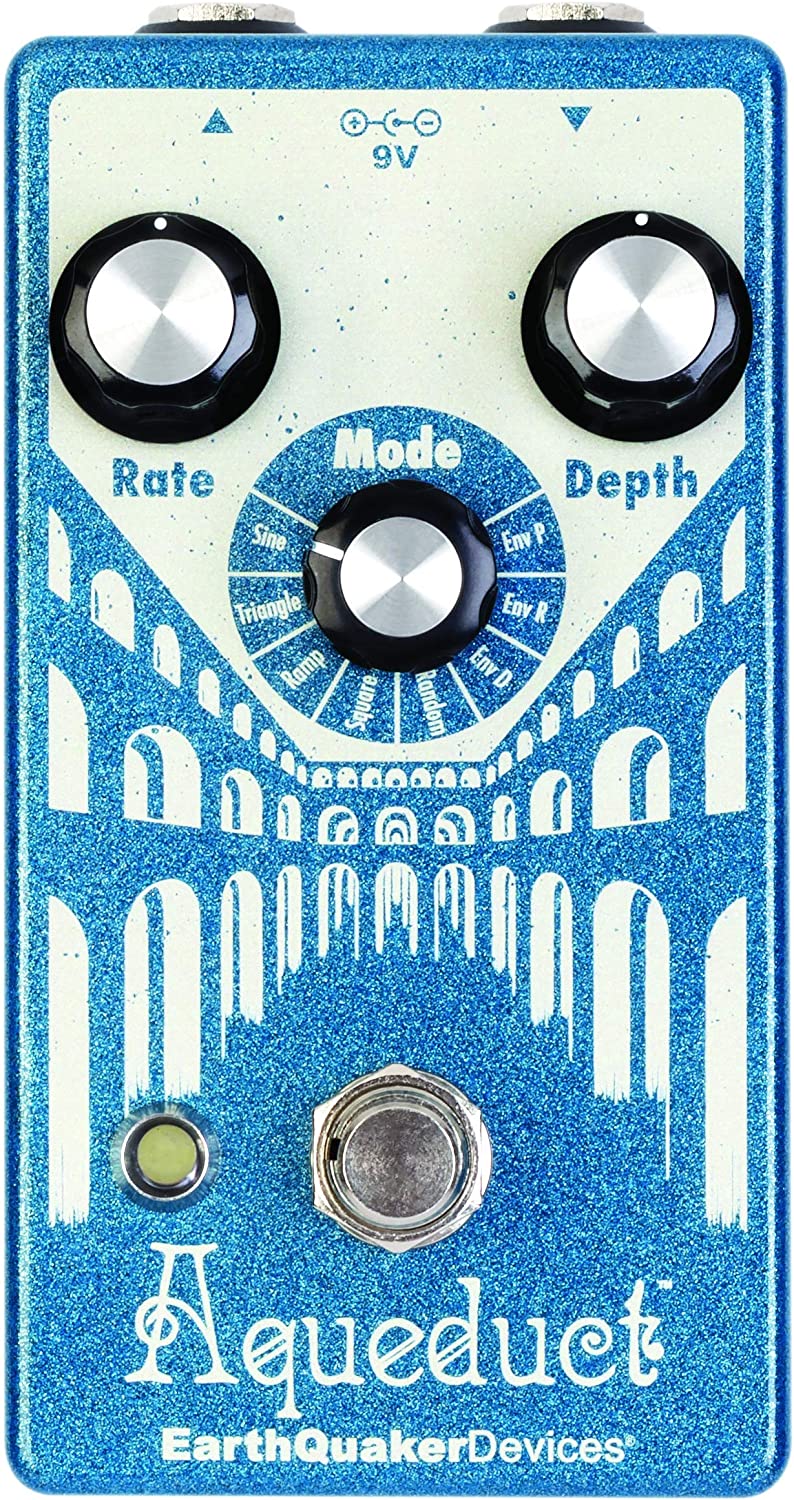
Featuring the perfect balance between analog and digital charm, the EarthQuaker Devices Aqueduct Vibrato Pedal is a musician’s dream.
With an all-digital wet signal path for a rich, high-quality output, and an all-analog dry signal path to keep the warmth and richness intact, this electric guitar pedal is meticulously designed for precision and versatility.
Exclusively configured with a relay-based Flexi-Switch, the pedal ensures seamless operation and user experience.
Creative options are endless with its eight distinctive modulation modes, making it possible to switch between gentle pitch rolls, rapid trills, quirky sonic squiggles, steady pulsations, and much more.
The Aqueduct Vibrato Pedal by EarthQuaker Devices finished in white and blue, physically stands out with its compact yet sturdy dimensions of 5.6 x 3.3 x 3.2 inches and the considerable weight of 0.8 pounds.
As the name suggests, this pedal is about creating an old-school pitch vibrato effect with a futuristic twist.
- My Review
Ah, stepping into the world of the EarthQuaker Devices Aqueduct Vibrato Pedal is like stepping into another dimension of sonic exploration.
This electric guitar’s pedal is not just a tool.
It’s an instrument in its own right.
What struck me was the combination of an all-digital wet signal path with an all-analog dry signal path.
The melding of this technology gave the output an unbelievably great balance between clarity and warmth.
But it doesn’t just stop at the great sound; it’s also a breeze thanks to the intuitive relay-based Flexi-Switch.
Somehow, it brings together simplicity and sophistication in the same package.
However, diving into the eight modulation modes is the most exciting part.
The versatility this pedal offers is truly insane.
It’s like having an entire toolbox at your fingertips, allowing you to switch between beautiful vibratos to touch-sensitive frequency modulations.
It embraces both solid retro vibes and sets its eyes confidently on the future by adding synth-like sonar pulses, unassumingly steady pulsations, and other mind-bending effects.
Now, it’s true this pedal is tough, neatly packed in white and blue housing, and has a good weight.
But it also has a drawback.
There seems to be a slight delay that somehow steals a bit of this product’s shine, and while I found the wildcard sonic squiggles intriguing, they might not be everyone’s cup of tea.
Even then, the EarthQuaker Devices Aqueduct Vibrato Pedal feels like a beast of a device.
It’s creative, it’s versatile, and it’s reliable.
Here are the ratings I’ll give to the EarthQuaker Devices Aqueduct Vibrato Pedal:
Sure, it has a few quirks, but that’s part of its appeal and what intrigues me to explore further.
It fits most tastes, and wow, it does make the guitar sing in the most unexpected ways!
- Pros:
- Exceptional combination of analog and digital.
- Offers immense versatility with eight modulation modes.
- Reliable and intuitive relay-based Flexi-Switch.
- Cons:
- Noticeable delay might be off-putting.
- Wildcard sonic squiggles not always useful.
My final verdict is that the EarthQuaker Devices Aqueduct Vibrato Pedal is an innovative and versatile piece of musical equipment that deserves a spot in every electric guitarist’s arsenal.
Despite minor setbacks, its impressive versatility, outstanding features, and superior performance make it an excellent value for its price.
It captures the essence of the EarthQuaker Devices brand and can transform guitar tones into something extraordinary.
Boss VB-2W Waza Craft Vibrato Pedal
Real-time control, vintage and custom vibrato settings with Waza Craft VB-2W.
The Waza Craft VB-2W offers an authentic reproduction of the classic BOSS VB-2 Vibrato in an all-analog stompbox, plus an innovative vibrato mode and real-time control function for enhanced expression. The rare pedal is one of the most valuable vintage BOSS effects on the market.
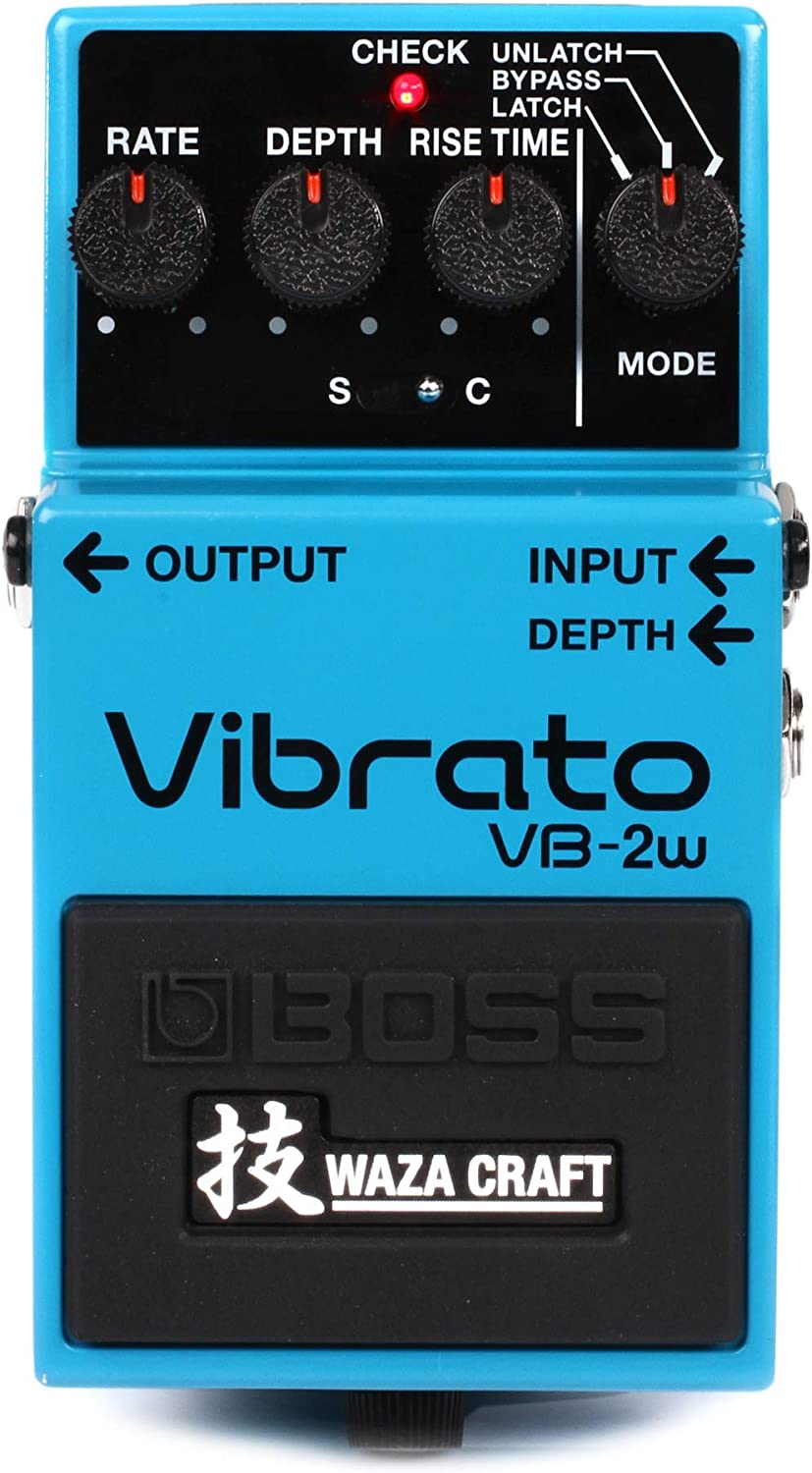
Meet the Boss VB-2W Waza Craft Vibrato Pedal, an impressive music equipment piece that commands respect due to its well-crafted features.
Sporting an alluring blue color, this expressive stompbox effect pedal transcends typical guitar effects with its individualistic sound.
This state-of-the-art piece boasts both vintage and custom vibrato settings, allowing it a certain versatility in its performance.
Its control layout has four knobs, making for an easy interface with three latch settings.
Notably, it also has an expression pedal input for more distinct sounds.
This versatile music device is as compact as it comes, with dimensions of just 6 x 3.75 x 2.75 inches and 1.28 pounds, ensuring easy portability.
Its unique architecture and sophisticated operation capture and elevate the true pitch-shifted vibrato of the original pedal while adding a refreshing new vibrato mode.
Invest in its enhanced expressive control for an unrivaled sound experience.
- My Review
I’ll tell you upfront: this Boss VB-2W Waza Craft Vibrato Pedal was a thrill to try.
If a music device could ever transport you to a whole new realm of sound textures, this is it.
The pitch-shifted vibrato? Simply out of this world.
Immersing myself in the captivating range of tones, you can’t escape the appreciation for the authentic recreation of the original pedal’s vibrato.
And the inclusion of an entirely new vibrato mode?
A game-changer – I felt like an aural artist with a fresh, unexplored palette.
Size and weight were optimal, being light and easy to transport, but I found the blue color particularly attractive, a nice touch for onstage aesthetics.
Something else that stuck out to me was the thing’s controls.
Striking the right balance between simplicity and versatility, the four-knob layout and three-latch settings felt intuitive and unobtrusive.
Dialing in just the right effect was a breeze.
But here’s a diamond feature that turned my head – the expression pedal input.
Influencing the vibrato with real-time foot control unlocked a different dimension to creating sonic artistry.
You know, the kind that can make your solo stand out or the rhythm groove more mesmerizing; yes, that depth of expression.
Using the VB-2W in the studio proved it could deliver consistently in performance, always matching the clarity of the original guitar tone without fighting for aural space.
It celebrates and reignites the spirit of its 1982 predecessor.
I did, however, notice a slight noise when I had a Klon-style buffer before the VB-2W.
It’s not an experience breaker but something to consider for the rig design.
Here are the ratings I’ll give to the Boss VB-2W Waza Craft Vibrato Pedal:
But I hold this pedal in high regard.
It’s an excellent reimagining of the original, bringing a past favorite to the modern realm with a unique flair.
- Pros:
- Authentic pitch-shifted vibrato sound.
- Versatile controls with real-time adjustment.
- Compact and lightweight design.
- Cons:
- Noise when coupled with Klon style buffer.
My final verdict is that the Boss VB-2W Waza Craft Vibrato Pedal is a remarkable piece of music equipment, striking an impressive balance between vintage authenticity and fresh innovation.
Despite a minor setback with noise when used with certain equipment, its ingenious features, compelling versatility, and superior performance make it a worthwhile investment, especially considering the reputation of the Boss brand.
It’s a product that crosses the threshold to new sonic landscapes.
If you’re searching for a gadget that transcends the ordinary, this pedal should have a reserved spot on your list.
Caroline Guitar Somersault Vibrato Pedal
Experience wild, rich, analog modulation with Caroline’s Somersault Pedal.
The Caroline Guitar Company Somersault Lo-Fi Modulator provides a wide range of sounds from gentle vibrato to glitchy bleep-bloops. Its analog gain stage, LFO, control set, and output mixing stage create a rich, powerful sound, with the added convenience of a digital chip for delayed wet signals.
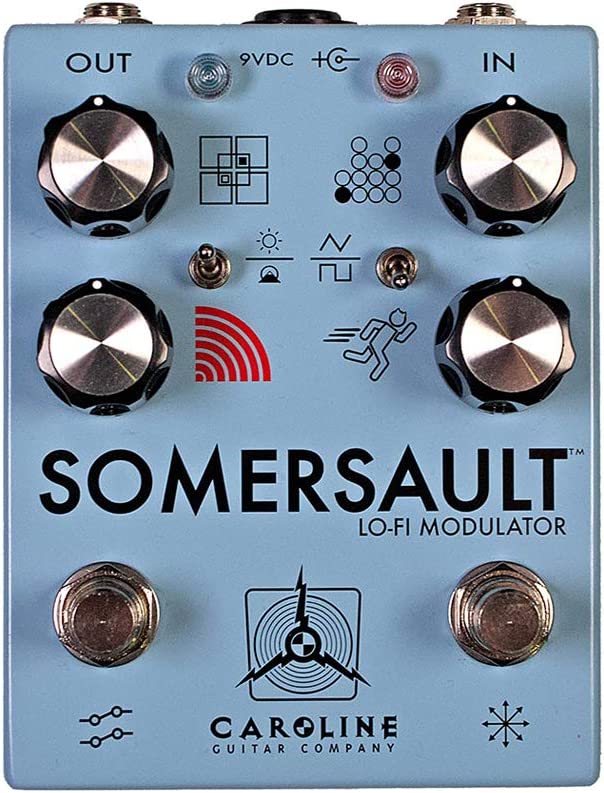
Meet Caroline Guitar’s Somersault Chorus – a pedal effect bringing depth, vibrancy, and versatility to your music.
This pedal effect is stylishly designed and compact.
Its dimensions are refined and small enough to fit neatly into your guitar setup at just 4.7 x 3.7 x 1.7 inches.
It runs on a suitable 9 volts and uses 30 milliamps of power.
It’s more than just your ordinary chorus pedal.
Beyond causing waves with its seasick wobbles, it ventures into sci-fi territory with glitchy bleep-bloops and whimsical huffs and puffs.
Yet, its genius lies in the ease of transition from these sensational effects to the nuanced, understated sound manipulations this pedal offers.
At its heart, this device is unique.
While its digital chipset works on the wet signal, its dry signal, Low-Frequency Oscillator (LFO), control settings, and output mixing are analog – promising a hearty, rich sound.
- My Review
Having delved into the nuances of the Caroline Guitar Somersault Chorus, it quickly became evident that this isn’t your everyday pedal effect—it’s a sonic marvel.
It manages to fuse the classic with the futuristic pleasantly.
It’s the size of a small book, fit well within my setup, and the vintage-style artwork on the metal casing is appealing.
As soon as I plugged my guitar in, I noticed that the pedal taps into a unique mix of digital and analog technology.
The result is a sound that tears through the listening space, hitting all the right notes with a desirable degree of accuracy.
Straightforward controls allow quick adjustments and striking variations, and the build quality reassures any concerns about durability.
The product shines in the modulation department.
With a tweak of a few knobs, I discovered a bizarre range of sounds.
From a beautifully lagging vibrato to a full-frontal chorus, the pedal doesn’t disappoint.
Searing character, it easily pulls off the classic 1980s style choruses and doubles effects for the more adventurous musicians.
But it doesn’t stop there; the pedal excels in creating experimental sounds.
It takes modulation to another level with warbled, glitchy stylings.
Whether it’s a subtle reverb or pushing boundaries into the wild territory, there aren’t many modulation sounds I couldn’t wrangle from the Somersault Chorus.
However, it’s not perfect.
While its experimental nature is its biggest strength, it might not be everyone’s cup of tea, given the high degree of spontaneity in the generated sounds.
Here are the ratings I’ll give to the Caroline Guitar Somersault Vibrato Pedal:
But it’s certainly a top contender for those after the rich analog feel and edgy modern innovation.
It handled everything I threw at it, delivering beautifully crisp sounds with a genuinely inspirational versatility.
- Pros:
- Compact and aesthetically pleasing design.
- Excellent, rich analog sound quality.
- High versatility in modulation effects.
- Cons:
- Experimental sounds may not suit everyone.
- Generated sounds can be spontaneously unpredictable.
My final verdict is that the Caroline Guitar Somersault Chorus surpasses expectations.
It is an excellent option for those exploring an extensive range of modulation sound effects or basking in rich, analog sound quality.
Its versatility in tone makes it a robust and reliable choice.
Despite the unpredictable nature of some sounds, the challenge will undoubtedly thrill ambitiously creative musicians.
The top-tier performance gives your music a unique edge, and the brand, Caroline, promises quality and durability.
As for value, it offers excellent bang for your buck, considering its vast array of features and exceptional quality.
Overall, this pedal is more than worth checking out.
Fender Bubbler Analog Chorus/Vibrato Pedal
True analog, switchable speeds, wave toggle, and stereo outputs for ultimate sound control.
The Fender Bubbler Chorus offers true analog sound with adjustable Rate and Depth controls, Wave toggle, Sensitivity control, and Stereo outputs for a full stereo field. It’s crafted from durable anodized aluminum, making it perfect for stage and studio use.
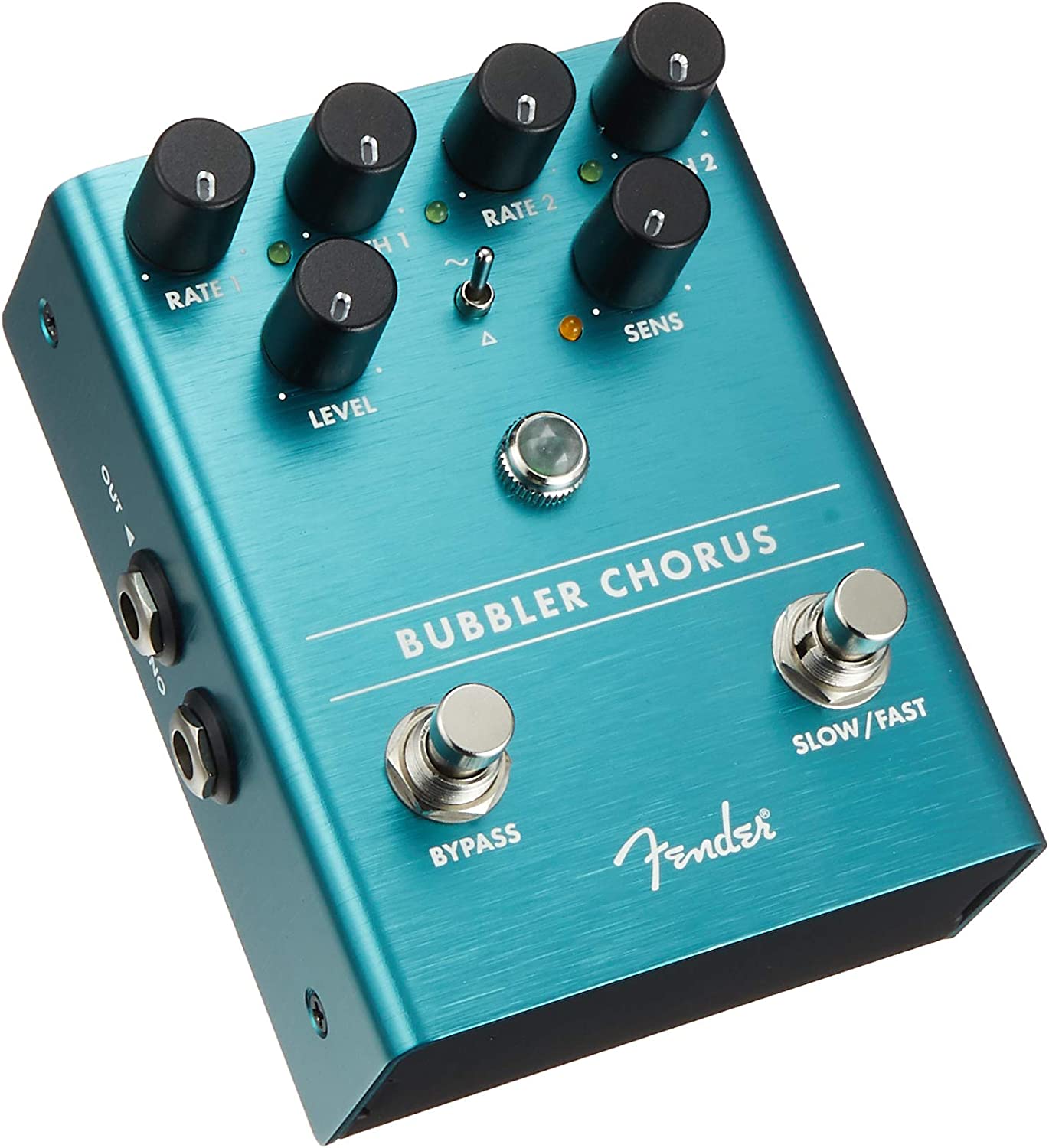
The Fender Bubbler analog chorus/vibrato pedal is a substantial piece of audio gear.
Its design borrows from the aesthetics of vintage effects pedals, yet it comes with advanced settings to customize your sound.
It offers switchable speeds that adjust the rate and depth for each sound section.
The sensitivity control is also unique to the Bubbler, which changes the modulation rate depending on how hard you pick.
With a switch, you can choose between sine and triangle waveforms.
Another noteworthy attribute is its stage-ready construction made of lightweight, durable anodized aluminum.
Plus, it features LEDs that illuminate the controls.
This pedal is distinctively colored in teal and black and weighs just half a kilogram.
The manufacturer touts it as catering for a vast stereo sound field, with a left and right output built-in.
However, keep in mind that it comes without a power adapter.
- My Review
Jumping headfirst into the Fender Bubbler Analog Chorus/Vibrato Pedal, I was immediately taken by its vintage-inspired charm.
Blended with modern technology, a touch of nostalgia creates an interesting contrast.
The steel-blue finish, coupled with its solid, stage-ready construction, adds a sense of confidence in its reliability.
Diving into its performance, the Bubbler proved to be no slacker.
The power of adjustable slow and fast speeds at my fingertips offers an expansive playground for creating unique soundscapes.
Fiddling around, I found the independent rate and depth controls offer precise customization.
My satisfaction peaked when I realized I could toggle between sine and triangle waves.
This flexibility opened up new doors for fine-tuning my sound.
One stand-out feature I must commend is sensitivity control.
It reacts to my playing dynamics, modulating sound at different rates depending on the intensity of my picking.
It energizes this pedal with interactive versatility.
You can create subtle undercurrents that bubble up when you lay low and bold swells when you give it a hard strum.
Despite its remarkable’s face-value features, the Bubbler isn’t without flaws.
Although solidly built, I’m disheartened that it doesn’t come with a power adapter or option for a 9v battery.
It’s almost as if I’ve been given a high-performance sports car without the keys.
Moreover, I was frustrated to occasionally discover an audible hissing or pulsing sound in the background.
Audio hiccups like these can be distractive, stealing away from the overall performance.
Yet, when all’s said and done, I must admit that the Fender Bubbler offers an exceptional sonic experience.
Here are the ratings I’ll give to the Fender Bubbler Analog Chorus/Vibrato Pedal:
It’s got its quirks, yes, but therein lies the charm.
Despite minor setbacks, it remains a robust contender that commands respect and attention.
- Pros:
- Adjustable slow and fast speeds.
- Independent rate and depth controls.
- Dynamic sensitivity control.
- Cons:
- Doesn’t include power adapter.
- No 9v battery option.
- Occasional hissing/pulsing sound.
My final verdict is that the Fender Bubbler Analog Chorus/Vibrato Pedal is a worthy addition to any musician’s arsenal.
It showcases an intriguing blend of vintage aesthetics and modern functionality, serving flexibility while not compromising performance.
Despite minor setbacks, such as no included power adapter and an occasional sound hiccup, it’s overall sound quality and tonal options are impressive.
Therefore, this pedal is a strong market contender for anyone with a love for detailed sound modulation and an appreciation for design.
Walrus Audio Julianna Deluxe Chorus Vibrato Pedal
Command lush tonal landscapes for a great tone.
Julianna is an all-analog, digital LFO stereo chorus/vibrato pedal with enhanced features, allowing for smooth chorus and seasick vibrato. It has selectable LFO waves, drift modulation, tap/expression control, and momentary features, creating sounds not found in traditional chorus pedals.
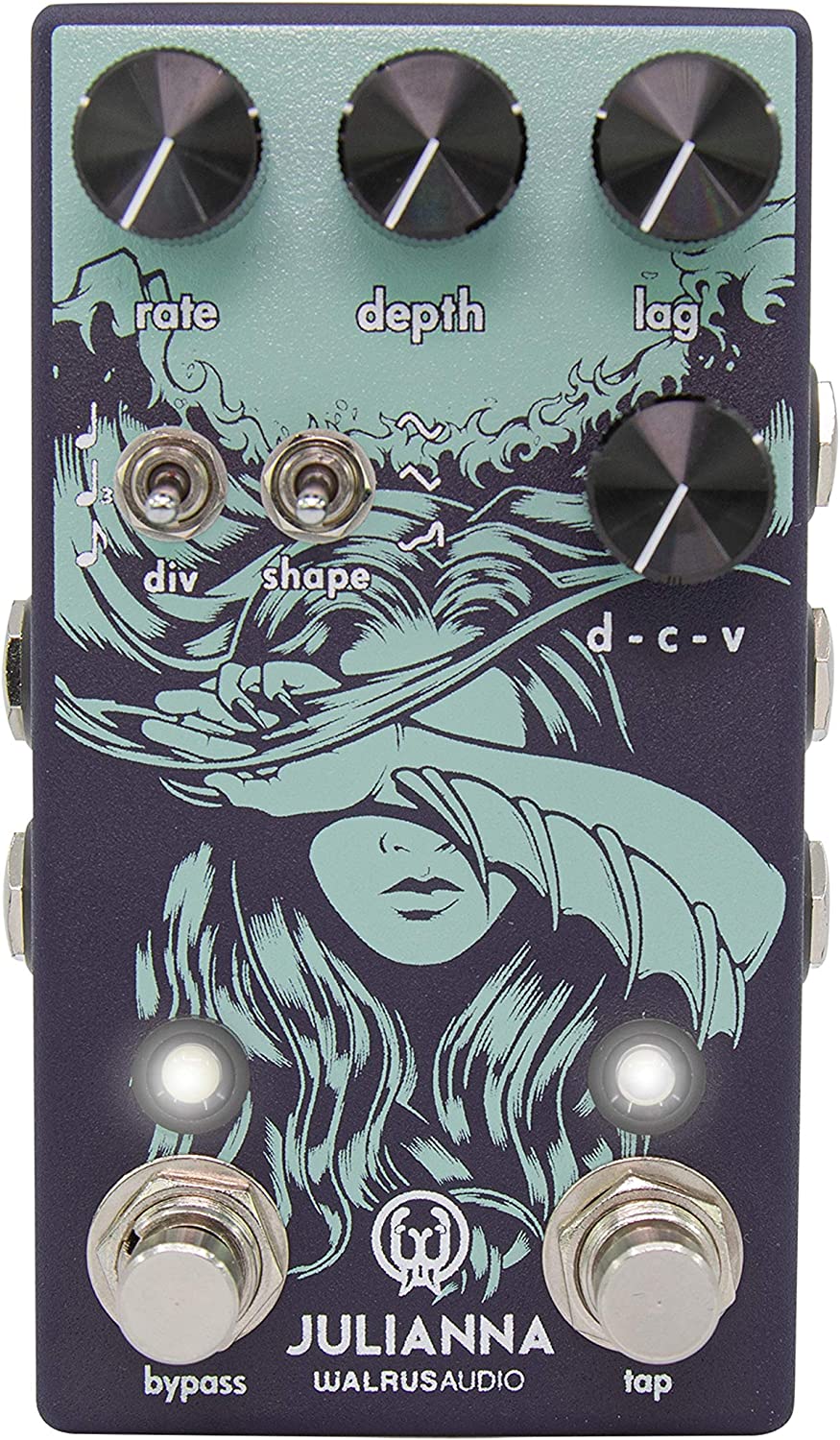
Meet the Walrus Audio Julianna Deluxe Chorus Vibrato Pedal, an evolution of the popular Julia Analog Chorus/Vibrato.
It’s an all-analog, digital LFO, stereo chorus/vibrato that pushes the boundaries of what’s possible with expanded features.
Whether you’re looking for a mild, smooth chorus or a seasick vibrato, Julianna can seamlessly craft a range of tonal landscapes.
Despite its innovative abilities, it doesn’t lose sight of essential controls like Lag, Dry-Chorus-Vibrato Blend, and selectable LFO wave shapes.
But what sets it apart are the new tricks up its sleeve – a Secondary LFO speed, modulation drift, tap expression control, and momentary features.
All these conspire to produce unique sounds beyond what traditional chorus pedals can achieve.
Its compact size doesn’t compromise in any way.
It measures just 6 inches by 4 inches, weighing a mere 0.16 pounds.
Its aesthetic appeal isn’t lost in the feature-rich design, thanks to its captivating color variations.
This is the future of chorus pedals – practical, innovative, and versatile.
- My Review
When I plugged in my guitar with the Walrus Audio Julianna Deluxe Chorus Vibrato Pedal, I felt a surging rush through my setup.
It’s striking how this small, lightweight pedal has the power to cast such a wide-ranging effect.
So, first things first, the killer in this beast is the Tap Tempo Control.
What a game-changer!
It allows me to seamlessly set the LFO rate as and when needed, either with the Rate knob or the tap tempo switch.
This kind of flexibility is rare to find in chorus pedals.
Talk about surprises, and the Stereo In/Out Jacks steal the show.
Whether I’m running mono in/mono out, mono in/stereo out, or even stereo in/stereo out, it caters to everything without a glitch.
But the true uniqueness lies in the momentary secondary LFO speed.
As I ramp up or slow down to a second LFO rate, I’ve noticed how it remarkably impacts the effect output.
Unlike anything I’ve experienced, this sets the Julianna pedal apart.
One feature that I’ve immensely enjoyed using is the Drift function.
Slightly changing the LFO rate as if there’s a little robot inside your pedal twisting the Rate knob gives you that spacious, ethereal modulation you simply can’t resist.
Now, does it have any downsides?
If I had to nitpick, I’d say the numerous settings could get a bit overwhelming initially if you’re new to such expanded features.
But trust me, it’s a small learning curve that opens many sound possibilities.
Here are the ratings I’ll give to the Walrus Audio Julianna Deluxe Chorus Vibrato Pedal:
To encapsulate it all, this Walrus Audio Julianna Deluxe Chorus Vibrato Pedal might be a hidden gem.
It’s no less than an adventure to play with, and every dial-in opens up an entire universe of soundscapes you’ve never explored before.
- Pros:
- Offers vast range of sound effects.
- Features innovative tap tempo control.
- Flexible stereo in/out jacks.
- Cons:
- Multiple settings might seem overwhelming initially.
- Falls on the higher end of the price range.
- Not suitable for those seeking a simple setup.
My final verdict is that the Walrus Audio Julianna Deluxe Chorus Vibrato Pedal is an outstanding piece of equipment.
Its sheer array of features, superior performance, and tone quality make it a truly versatile choice for any guitar setup.
While the price point may be a consideration for some, the value it brings in terms of its unparalleled soundscapes more than justifies it.
This pedal is a testament to the quality that Walrus Audio consistently delivers.
It’s a smart investment for musicians seeking to broaden their sonic horizon, and I highly recommend it.
Jackson Audio New Wave Vibrato Pedal
Provides rich stereo chorus and vibrato with simple controls and plug-and-play convenience.
Jackson Audio’s New Wave pedal delivers a stereo analog chorus & vibrato effect for guitarists, plus a durable, high-quality MASTER .33 foot shielded mono cable for a reliable 6.3mm connection.
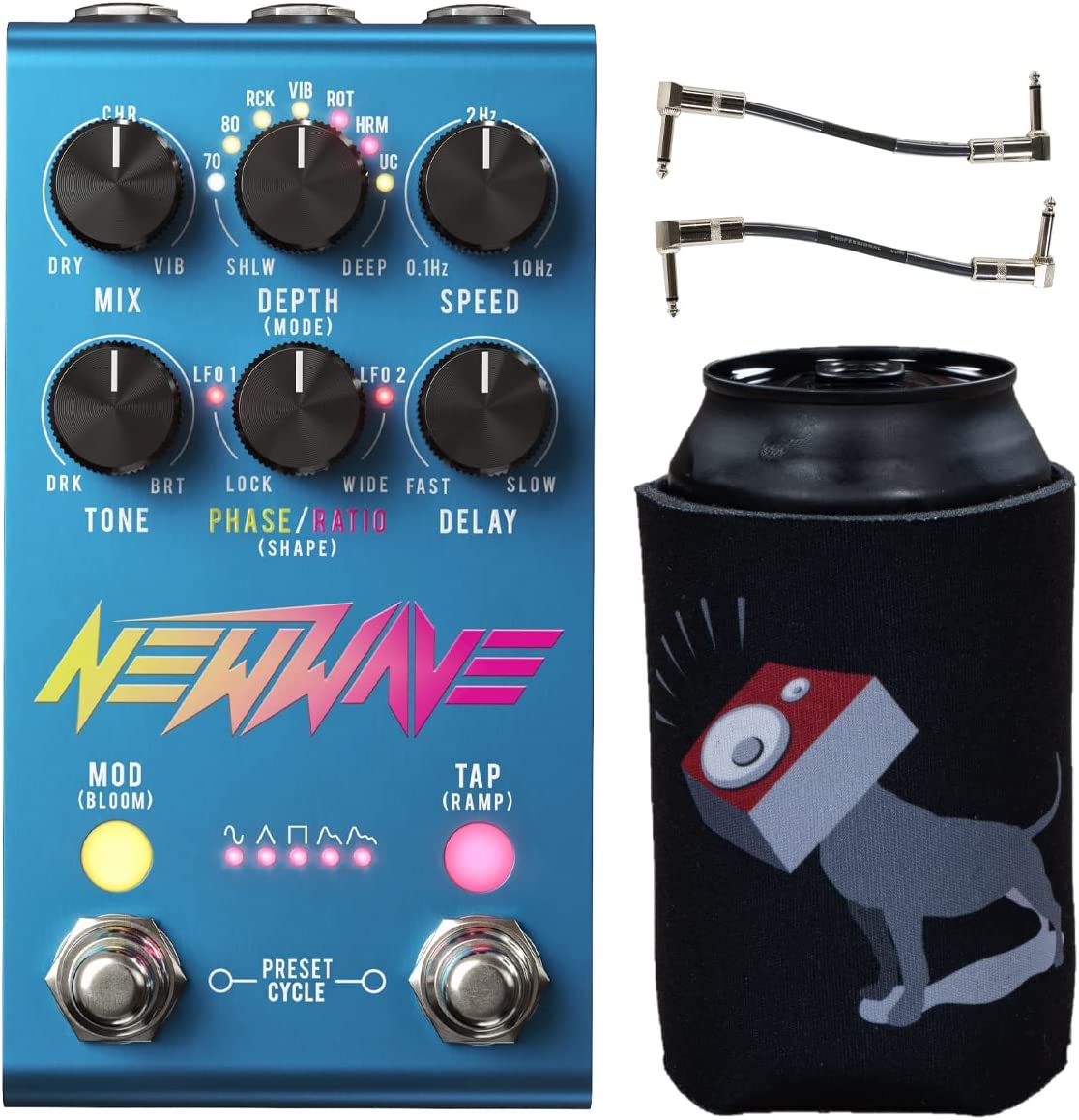
Meet the Jackson Audio New Wave, an 18-volt Stereo Analog Chorus and Vibrato pedal.
With its innovative design and diverse functionality, this device is perfect for guitar enthusiasts looking to enhance their playing.
It comes equipped with patch cables and a bonus beer hugger.
The unit offers easy knob control types and connects to a power source via a plug.
It also showcases sturdy dimensions, precisely 8 by 6 by 4 inches, making it compact and space-efficient.
Furthermore, it includes a master .33-foot shielded mono cable fitted with a 6.3mm male plug on both ends.
All of these elements contribute to the flawless functionality of the pedal.
Manufactured by the reliable brand, PitbullAudio, Jackson Audio New Wave offers a distinctive chorus style that distinguishes it from other pedals in the market.
Offering an optimal sound experience, this pedal marries convenience and efficiency seamlessly.
- My Review
Well, let me tell you, the Jackson Audio New Wave Stereo Analog Chorus and Vibrato Pedal are truly something to sing about.
Right off the bat, its 18-volt power stood out and promised an excellent, more intense signal-to-noise ratio.
Plug it in, and you’re set to experience a robust and clean sound.
Chorus and vibrato in one pedal, now that’s versatility.
With the chorus style effect, I noticed a warm, immersive sound.
But let’s not forget the vibrato!
It’s like a portal to the vintage analog days, evoking that nostalgic vibey feel.
Each rotation of the knob led to a subtle yet noticeable change in sound, offering precision control.
Did I mention the dimensions? It’s a compact powerhouse at 8 by 6 by 4 inches, which is just about perfect for those looking to save space on their pedal board.
The appeal doesn’t stop there; the beer hugger it comes with is an original, fun addition that indirectly acknowledges the hours spent jamming.
Connection matters too, and the included MASTER .33 foot shielded mono cable with 6.3mm male-to-male plugs leaves no room for complaints.
I was happy to find its shielding effectively eliminated any unwanted noise or hum.
If I were to pick a bone, I’d wish for more variations in the vibrato effect.
While it delivers a good vintage feel, it might have done with more range.
But let’s say, in the grand scheme of things, that’s a minor quibble for an otherwise exceptional pedal.
PitbullAudio’s Jackson Audio New Wave is a mixed bag of great design, remarkable effects, efficient dimensions, and thoughtful accessories.
Its features blend cohesively to offer an amplified experience that does more than tweak your sound; it enhances it.
Here are the ratings I’ll give to the Jackson Audio New Wave Vibrato Pedal:
Despite the slight hiccup with the vibrato range, I’d still assert that this pedal holds its ground pretty well in the audio gear landscape.
It’s far from average, edging towards remarkable.
- Pros:
- Excellent 18-volt signal-to-noise ratio.
- Versatile with chorus and vibrato effects.
- Comes with useful accessories.
- Cons:
- Limited range in vibrato effect.
My final verdict is that the Jackson Audio New Wave Stereo Analog Chorus and Vibrato Pedal is a solid investments for any guitarist.
Despite a minor shortcoming in the vibrato range, its impressive versatility, advanced features, distinct tone, and reliable performance make it stand out.
Alongside the considerable brand reputation and value for money, this pedal scores high performing and is worth considering for musicians aiming to enhance their sound.
Dunlop Authentic Jimi Hendrix ’68 Vibrato Pedal
Authentic Jimi Hendrix ’68 Shrine Series Uni Vibe Chorus/Vibrato Pedal for legendary tones.
This Dunlop Jimi Hendrix ’68 Shrine Series Uni Vibe Chorus/Vibrato Pedal is inspired by Jimi Hendrix’s iconic effects, featuring custom finishes and modern appointments. Includes a .33 foot shielded mono cable for easy setup and connection.
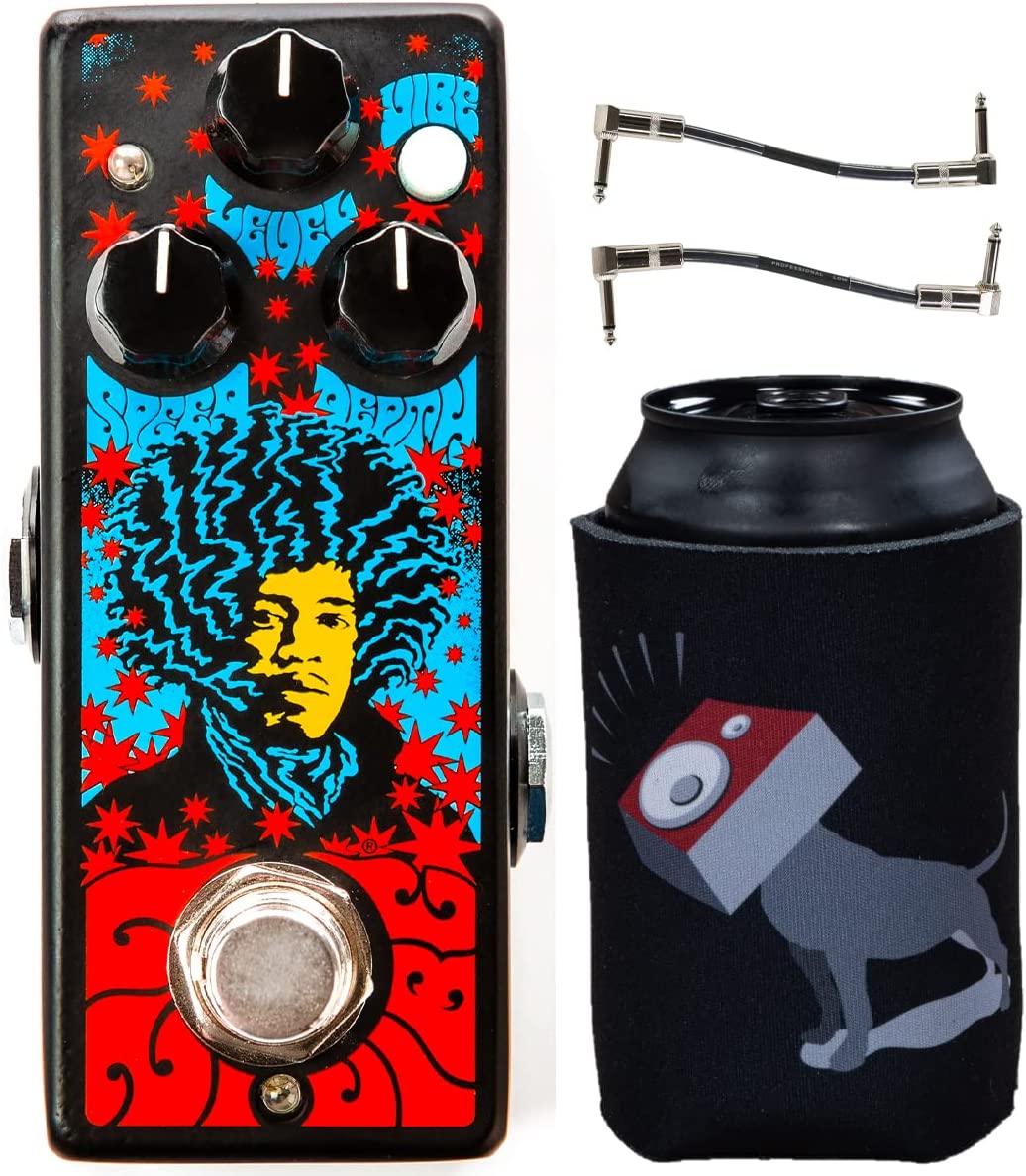
This authentic Jimi Hendrix ’68 Shrine Uni Vibe Chorus/Vibrato Pedal, made by Dunlop, is designed for the true lovers of Jimi Hendrix and his electrifying music.
Bundled with patch cables and a beer hugger, it mimics the legendary effects used by Hendrix himself.
The package includes an artisanal .33-foot shielded mono cable connecting two 6.3mm male plugs.
It is also crafted as a tribute to the iconic 1968 Shrine Auditorium concert, utilizing the special artwork from that time by rock artist John Van Hamserveld.
The pedal is from PitbullAudio and is designed with the analog signal format.
It comes compact with 8 x 6 x 4 inches dimensions and is powered by a plug source.
Adding to their appeal, these special edition pedals come in a mini house with modern features like LEDs and power jacks.
- My Review
Walking in the shoes of the iconic Jimi Hendrix, I found the ’68 Shrine Uni Vibe Chorus/Vibrato Pedal extremely fascinating.
Made by Dunlop, it’s much more than just an instrument – it’s like a time capsule, transporting you back to the nostalgic era of Jimi Hendrix.
A key highlight is the meticulous craftsmanship that goes into replicating the exact effects used by Hendrix.
This level of attention to detail lets you truly immerse yourself in the experience.
As a bonus, you are also given a perfectly shielded .33-foot mono cable with twin 6.3mm male plugs.
Admittedly, I was initially drawn to the pedal for its tribute to the 1968 Shrine Auditorium concert with its striking artwork by John Van Hamserveld.
But my exploration of this product revealed more than meets the eye.
For one, the signal format is analog, harking back to a less digital-dominated era, yet it produces a pure, organic sound.
PitbullAudio, the brains behind the pedal, haven’t skimped overall convenience.
The power source is a simple plug, handy in the fast-paced, often cluttered world of music.
Measuring eight by six by 4 inches, it is compact, portable, and practical.
I particularly appreciated the addition of modern features like LEDs and power jacks in the mini housing.
On the downside, the pedal may initially seem intimidating to those new to Hendrix’s music or the mechanism of such pedals.
Here are the ratings I’ll give to the Dunlop Authentic Jimi Hendrix ’68 Vibrato Pedal:
Still, once you get the hang of it, you’d appreciate its complexity and quality.
So, plunge in, experiment, and let your creativity flow with the Dunlop Authentic Jimi Hendrix ’68 Shrine Series Uni Vibe Chorus/Vibrato Pedal.
- Pros:
- Impeccable replication of Hendrix’s effects.
- Compact size with modern appointments.
- Included .33 foot shielded mono cable.
- Cons:
- Can be intimidating for beginners.
- Reliance on plug for power source.
My final verdict is that the Dunlop Authentic Jimi Hendrix ’68 Shrine Uni Vibe Chorus/Vibrato Pedal is a remarkable piece of musical equipment that expertly bridges the past and present.
Its eye-catching exterior, high-quality features, and commendable performance offer a nostalgic yet innovative musical experience.
While there could be some improvement in versatility, the overall quality and value of the product still make it a worthy addition to any musician’s kit.
DigiTech Ventura Vibe Vibrato Pedal
Authentic rotary/vibrato tones, stereo I/O, true bypass.
DigiTech’s Ventura Vibe Rotary/Vibrato pedal provides vintage and modern effects with adjustable tone and drive, plus a foot-switchable speed function for adding spinning, swaying movement to your guitar playing. Its unique design features bicolor LED indicator, true bypass circuitry, and stereo 1/4″ inputs and outputs.
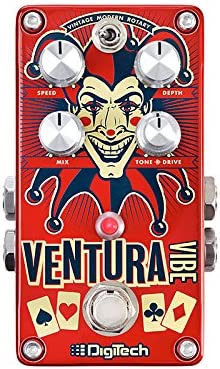
The product, titled DigiTech Ventura Vibe, is a vibrato pedal designed particularly for guitars.
This musical device is known for its three distinctive rotary/vibrato kinds.
The vintage mode brings back the allure of old-school Uni-Vibe effects, while the modern mode offers a rotation rooted in clear pitch-based vibrato.
The icing on the cake is the rotary, which ideates the Leslie speaker’s rotary effect.
Its unique versatility, jointly considered with exclusive Speed, Depth, and Mix controls, introduces a wide spectrum of modulation.
The design integrity of this pedal enhances performance; it features smooth switch technology, True Stereo I/O, and steadfast True Bypass circuitry, amplifying the purity of your tone.
Also included are accessories like Stomp lock knob guards and pedalboard pads.
A compact format distinguishes the pedal’s architectonics; it radiates in bright red, weighing a mere pound.
This high-voltage DigiTech Ventura Vibe is a valuable musical accomplice that effectively manipulates your music.
- My Review
My experience with the DigiTech Ventura Vibe pedal was full of sonic twists and turns.
With three distinct rotary/vibrato effects, this pedal paints an array of soundscapes, allowing me to easily glide my guitar through classic vintage tones and modern effects.
Adding the Ventura Vibe to my setup, I could almost feel the echoes of the past reverberating through the vintage setting.
It mimics vintage phaser-based Uni-Vibe effects with nostalgic warmth, though I did notice a slight reduction in midrange frequencies when activated.
Switching to the modern mode delivered a fresh, pure pitch-based vibrato effect.
Inspired by a Leslie speaker theme, the rotary was a game changer, adding a new dimension to my sound.
Not just content with its sonic idiosyncrasies, the Ventura Vibe impressed me with its thoughtful design and attention to stage-ready details.
Its True Stereo I/O and True Bypass circuitry maintained my tone’s integrity, whether in bypass or operation mode.
Perhaps one of the pedal’s appealing qualities includes the surprisingly compact size boasting a vacuum-style footswitch, with a stage appeal accentuated by its striking red coat.
Its intelligible interface underwent serious appreciation, with the vibrant LED light being a functional bonus.
Continuously powered by a 9V DC supply, integrating this pedal into my existing pedalboard was a breeze.
Even in moments when I sought to push the boundaries, the depth and breadth of control this pedal offered – from amplitude modulation to speed variances – did not disappoint me.
Yet, while its versatility is admirable, I felt the foot-switchable speed feature could use a more advanced user control limit.
Here are the ratings I’ll give to the DigiTech Ventura Vibe Vibrato Pedal:
Despite some minor areas needing enhancements, it’s fair to say the DigiTech Ventura Vibe pedal does a pretty compelling job of achieving vintage, modern, and rotary effects.
It brought a versatile personality to my music, infusing unique charm and distinctiveness.
- Pros:
- Presents three unique rotary/vibrato effects.
- Compact design with stage-ready features.
- True Stereo I/O and True Bypass circuitry.
- Cons:
- Vintage setting marginally dips in midrange frequencies.
- Speed function lacks advanced user control.
- Stereo rotary effect could be improved.
My final verdict is that the DigiTech Ventura Vibe Pedal is a versatile, feature-rich accompaniment to any musician’s setup.
The pedal’s versatility and features shine brightly, including three unique rotary/vibrato effects and thoughtful design elements.
The tone, however, could use a few tweaks, notably with the diminished midrange frequencies in the vintage setting.
There’s a slight room for performance improvement, especially with the speed function’s user control.
Nevertheless, the trusted brand reputation and high value for the price make this pedal a worthy consideration for musicians looking to add an extra edge to their sound.
MXR M-68 Vibrato Pedal
Legendary ’60s vibe sound in a modern, compact pedal.
The MXR Uni-Vibe Chorus/Vibrato offers classic ’60s tones in a modern, compact, true bypass design. Easily adjust the effect with the VIBE, LEVEL, SPEED, and DEPTH knobs for a wide range of chewy chorus and vibrato textures.
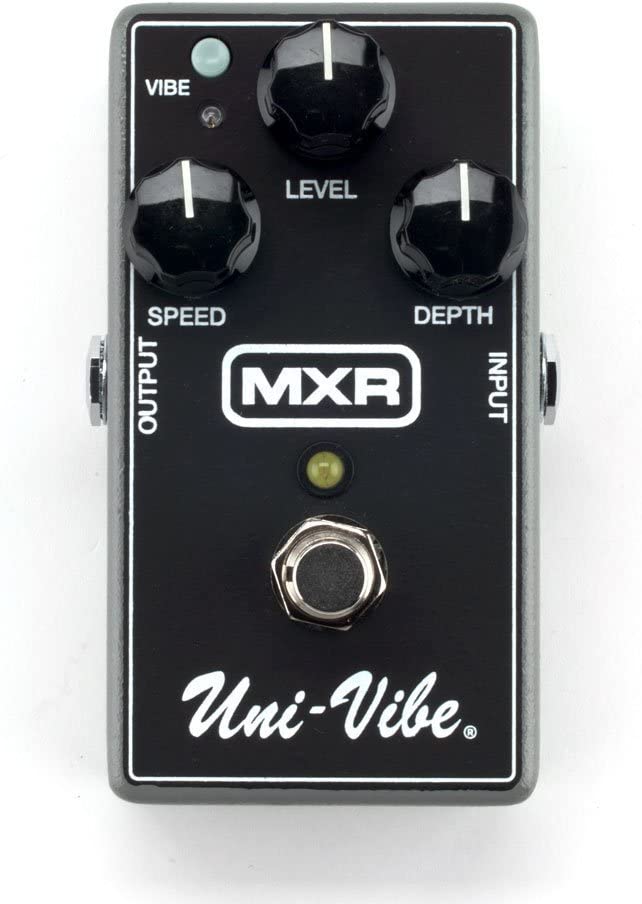
Take a look at the MXR M-68 Vibrato Pedal – it’s an essential tool for today’s musicians!
This isn’t just any pedal; it’s a compact powerhouse famed for recreating the sumptuous, rich textures cherished by musicians since the late 1960s.
Housed in an MXR-standard framework, this dreamy device is super light and compact, surpassing its predecessor in size and weight-wise.
An important feature is the true bypass switch that facilitates pure and unaltered tone when the effect is unnecessary.
User-friendly, it comes with a three-knob interface for an easy setup: LEVEL for volume control, SPEED for adjusting the sweep rate, and DEPTH for intensity.
For the uninitiated, there’s a convenient VIBE switch for choosing between Chorus Mode (a mixture of the dry signal and pitch-shifted signal) and Vibrato Mode (strictly pitch-shifted signal).
This beauty, encased in a black exterior and powered by 9 volts, is your ticket to revolutionizing your sound palette.
- My Review
Ah, the MXR M-68 Uni-vibe Chorus/Vibrato pedal — a marvel to behold and a pleasure to use.
From the get-go, it’s clear that this gem offers something exceptional.
A truly lush, vibrant soundscape unlike any other.
This pedal effortlessly creates the ambiance of the late ’60s, transporting you back in time with a soulful resonance.
It’s impressive how its texture carries an almost tangible weight that will sway even the most seasoned player.
Housed in an MXR-standard case, the sleek, black exterior and lightweight construction make this pedal a practical addition to any musician’s toolbox.
Plus, it operates on a healthy 9 volts, giving you enough power to turn any regular gig into an unforgettable experience.
Experimenting with the settings was a breeze, thanks to the three easy-to-use knobs.
LEVEL, SPEED, and DEPTH? It couldn’t get simpler than that!
A quick turn adds an extra element of volume, changes the sweep rate, or deepens the intensity, allowing me to fine-tune the sound to my liking.
I found the VIBE switch notably helpful for transitioning from the Chorus Mode, mixing the dry and pitch-shifted signals, to the Vibrato Mode, which only highlights the pitch-shifted signal.
This little switch allows for various possibilities, escalating the pedal from a simple tool to an indispensable part of my performance.
What strikes me most, however, is the true bypass switching.
Honesty in tone is rare, and it’s remarkable how this pedal respects your original sound, stepping into play only when needed.
It respects the user’s expression, adding only what you want to its character, nothing more.
On a critical note, it is worth mentioning that though it is simple to use, it might take some practice before achieving your desired sound.
Its versatility and variety of options will require trial and error, and patience is truly a virtue here.
Here are the ratings I’ll give to the MXR M-68 Vibrato Pedal:
Revolving your world around the MXR M-68 Uni-vibe Chorus/Vibrato pedal might seem intimidating initially, but let me assure you, the tonal range and textured vibrato it can add to your repertoire is well worth the effort.
It’s a small investment to pursue that legendary tone we musicians chase.
- Pros:
- Recreates alluring late ’60s soundscape.
- Features simple three-knob interface.
- Incorporates true bypass switching.
- Cons:
- Requires experimentation for sound precision.
- Offers wider range to experienced players.
My final verdict is that the MXR M-68 Uni-vibe Chorus/Vibrato Pedal is a fantastic addition to any musician’s gear.
Its superior tone, impressive versatility, and array of user-friendly features make it excellent value for money.
Despite requiring a bit of practice and experience for optimal use, it delivers once you get the hang of it.
With its authentic late ’60s soundscape and true bypass feature, you get unmatched quality and performance.
The MXR brand backing adds to its appeal, further assuring its high standard.
Whether you’re a seasoned pro or an ambitious beginner, this pedal could be the tool to elevate your music to the next level.
Keeley Seafoam Plus Vibrato Chorus Pedal
Provides lush, wide, and musical tones for guitar and bass.
Seafoam Plus Chorus provides a versatile range of chorus, flanging, and tremolo, with true chorus and ADT plus reverb. It offers both vintage and modern tones, and is tuned for both guitar and bass, allowing you to create unique sounds.
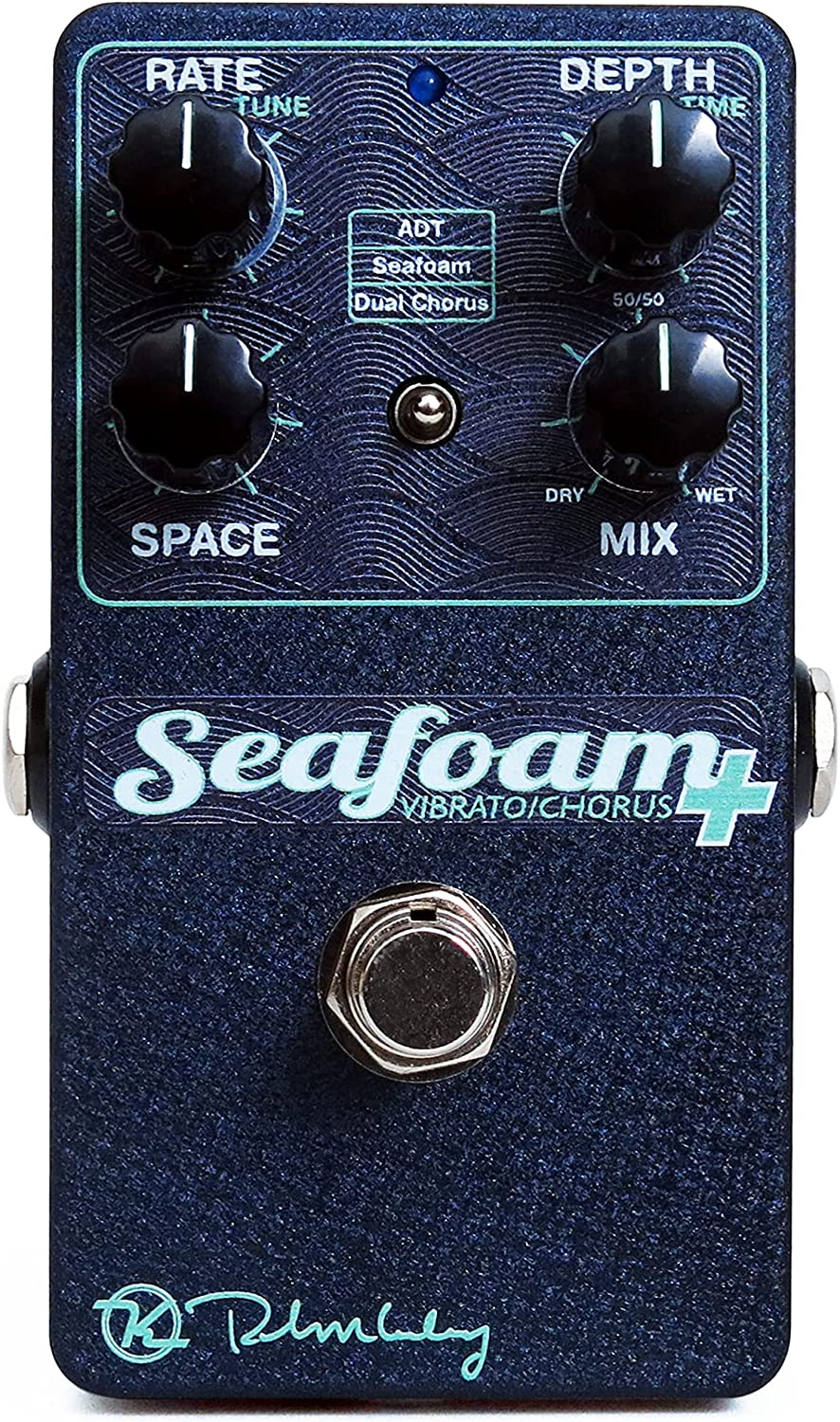
Meet the Keeley Seafoam Plus Vibrato Chorus Effects Pedal – a new breed in sound effects.
Wrapped up in an appealing blue, this guitar pedal takes your regular toning to a new level with its unique tri-mode chorus feature.
Precision tuned for guitar, it also caters to bass players, who will find custom voices and modes, such as tremolo and flanging.
Thanks to an innovative frequency crossover-based dual-chorus engine, you can segregate and alter the chorus depth for the highs and lows separately.
It’s a sleek gear with dimensions of 4.41 x 2.68 x 2.01 inches and a mere 0.28 kilograms.
Unleash the power of genuine chorus sounds that were until now confined to high-end DAWs and music studios.
It opens up new dimensions with internal switching between classic and contemporary tones.
- My Review
Sitting down and plugging in the Keeley Seafoam Plus Vibrato Chorus Effects Pedal for the first time, I immediately get a sense of its unique offering.
Besides the striking blue color, the pedal’s capabilities are worth noting.
Designed not just for guitar but with a mind towards bass players, the tones it can produce are quite distinctive.
The flanging and tremolo modes tuned explicitly for bass music are a significant game-changer.
Fiddling with the innovative frequency crossover-based dual-chorus engine, it’s clear that the focus is on precision and depth.
Adjusting these for highs and lows individually is an experience.
It provides a level of detail and control I’ve rarely seen in a pedal of this size and price range.
Switching between the classic and modern tones, a fresh variety of sound spreads opens up further.
Thanks to the tri-mode chorus feature, the sound I can get is akin to what I’d expect from a luxury DAW or a professional music studio.
The intricate flexibility of this pedal is undoubtedly its forte.
Here are the ratings I’ll give to the Keeley Seafoam Plus Vibrato Chorus Pedal:
However, it’s not all sunshine and rainbows with Seafoam Plus.
The choice of concentrating more on graphics and digital processing over the typical analog sound creates a particular tone,
- Pros:
- Unique tri-mode chorus feature.
- Geared towards bass players too.
- Innovative frequency crossover dual-chorus engine.
- Cons:
- Graphics over analog sound choice.
- Brand dilution due to reduced costs.
- Tone may appear questionable to some.
My final verdict is that while the Keeley Seafoam Plus Vibrato Chorus Effects Pedal is a worthy choice, it may not be for everyone.
Its boutique features and tri-mode chorus capability stand out as true strengths, adding various new tones.
However, for those who seek traditional analog sounds, the emphasis on digital processing may be a drawback.
Despite this, considering the versatility and comfort of use it offers, it holds its value well and would be a smart addition to any musician’s setup.
Caline Mini Guitar Vibrato Pedal
A compact, versatile guitar pedal delivering a tonally pure performance.
The Caline G Series Pedal is an innovative mini pedal notable for its unique surface design. The Timberwolf Vibrato variant provides a spectrum of sound, from gentle sheen to intense warble. The digital circuit design maintains tonal clarity. Compact and lightweight, it has a robust aluminum-alloy housing and a satisfying on-off button. It runs on a DC 9V Adapter (not included) and is favored by blues, rock, and metal guitarists.
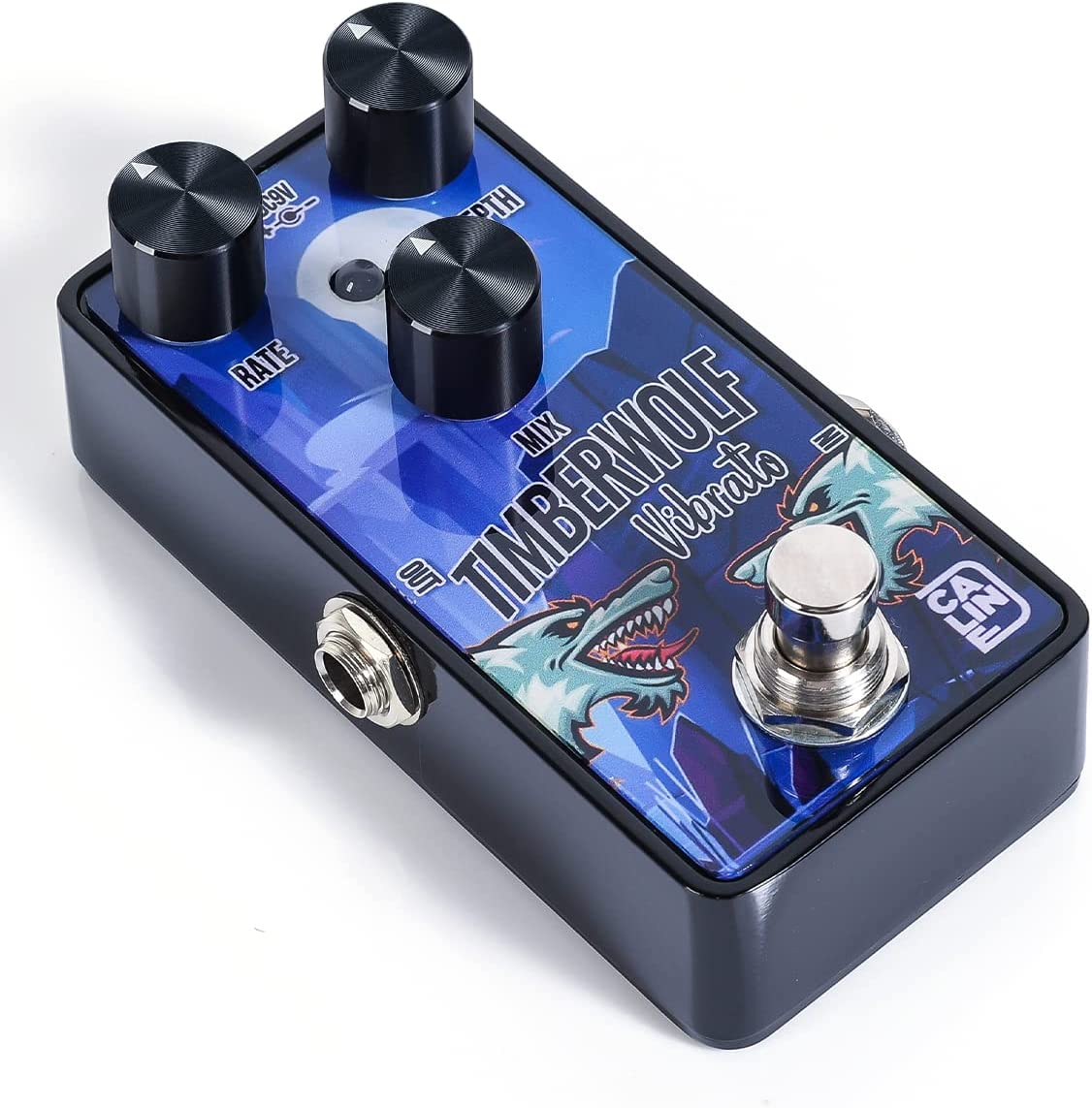
Are you looking for a full pedal experience condensed into a mini-package?
The Caline Mini Guitar Vibrato Pedal G006 is a compact yet dynamic addition to your music setup!
Part of the exclusive and powerful G Series, stands out with its distinctive surface treatment, which is uncommon in the merchandise line-up.
This unique digital Vibrato pedal maintains the integrity of your tone with its digital circuit design, giving you a clear and purer sound.
Moreover, weight and size are important factors for a musician on the go.
This mini-style pedal is small, lightweight, and delightfully portable.
The robust aluminum-alloy housing ensures durability and gives a satisfying click while switching on and off.
One exclusive advantage of this pedal is its compatibility with electric guitars and bass guitars – a multi-functional gem!
It’s a well-liked companion for blues rock and metal guitarists and is powered by a DC 9V adapter supply with a rated current of 100mA.
The flexibilities of this tiny titan are sure to impress you.
- My Review
Having experienced the Caline Mini Guitar Vibrato Pedal G006 G Series, it became crystal clear why it holds its own in the music world.
It’s inherently crafted for excellence, beckoning a double-take at its distinct surface treatment, rare in the market.
An initial exploration opened a catalog of rich, expressive sounds showcasing the pedal’s brilliance.
Its digital circuit design is of high note, preserving the purity and clarity of tone, a feature that musicians across the spectrum can appreciate.
Its functionality does not compromise the weight and size.
It’s lightweight, portable, and well-designed to fit into compact spaces.
With a resilient exterior, the aluminum-alloy housing assures durability while providing a satisfying, hardy click upon activation—an impressive feat considering its size.
The compatibility feature is a significant plus, catering to electric and bass guitars – a proud salute to its multi-functionality.
Such versatility opens an attractive avenue for blues rock and metal guitarists, who often put it into high gear.
Surprisingly, the power dynamics have been well-considered in this mini gem.
It effortlessly packs a punch with a DC 9V adapter supply and a robust current rating of 100mA, ensuring a sound experience that indeed resonates.
However, one slight bump in the road may be the sound this pedal tends to add to original tunes.
While its function as an overdrive pedal is satisfactory, it continues to have some background hiss.
Here are the ratings I’ll give to the Caline Mini Guitar Vibrato Pedal:
Though perceptible, it’s non-intrusive and can be overlooked within the overall experience.
Considering the aesthetics, hardware quality, and sound features, the Caline Mini Guitar Vibrato Pedal remains exciting, potentially delivering an excellent overall sound experience supplemented with character and depth.
- Pros:
- Compact, portable design.
- Enhances tone clarity and purity.
- Flexible compatibility.
- Cons:
- Sensitive control knobs.
- Requires DC 9V Adapter, not included.
- Added noise on higher settings.
My final verdict is that the Caline Mini Guitar Vibrato Pedal G006 is a worthy addition to any guitarist’s pedal collection.
It’s versatility, unique sound processing capabilities, convenient compact size, and sturdy design make it a remarkable tool for practicing and performing.
It offers a commendable value for the price point, but potential users should note the nuances of its tone and performance before purchasing.
JAM Pedals Ripply Fall RetroVibe Vibrato Pedal
Smooth, lush-sounding chorus/vibrato, sweet 2-stage phaser, Leslie speaker simulation, and more.
The WaterFall/Ripple dual pedal offers unique features, including a middle footswitch for Leslie speaker simulation, ring modulator effects, and more. Expression pedal inputs allow for real-time control of Depth and Speed. The WaterFall provides lush Chorus/Vibrato while the Ripple offers a smooth, transparent Phaser.
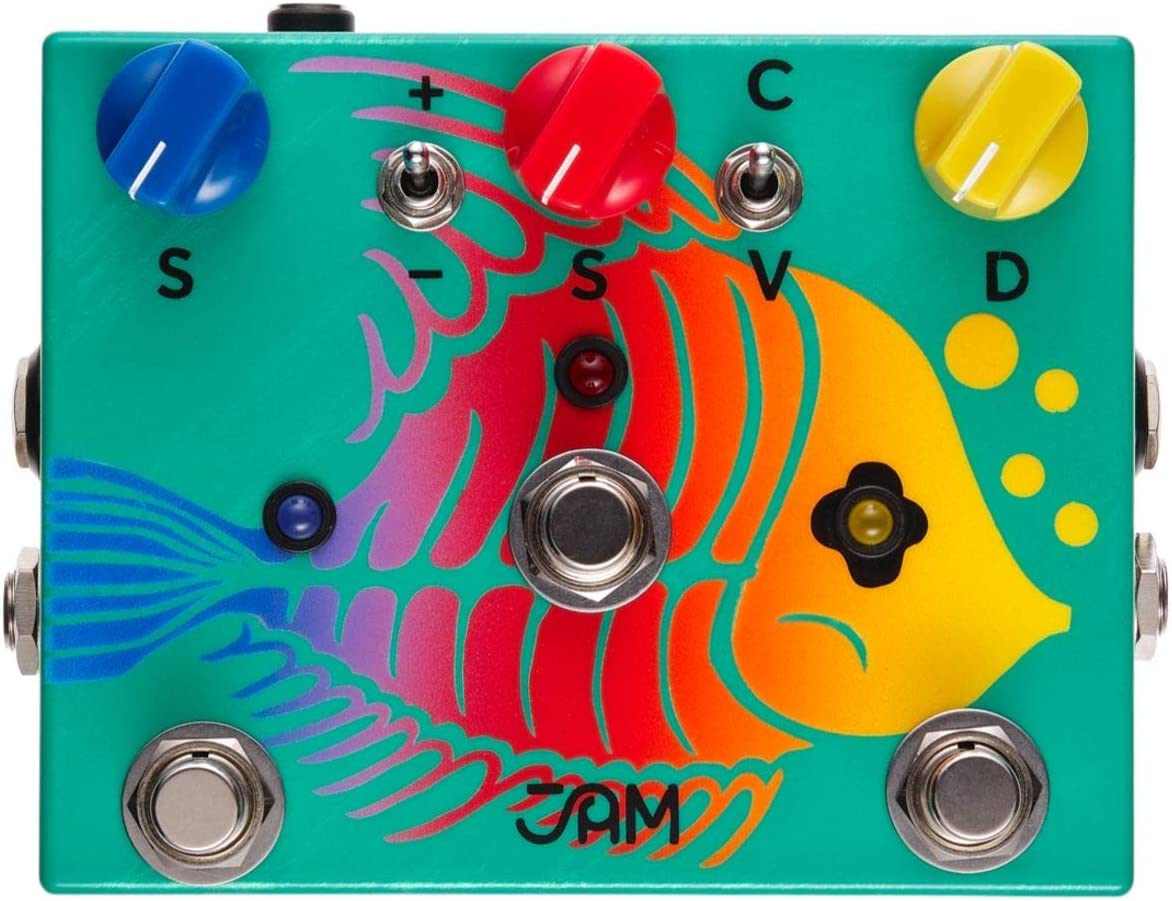
Introducing a versatile gem from JAM Pedals, the Ripply Fall RetroVibe is an all-in-one chorus, vibrato, and phaser pedal that delivers a gentle wave-like symphony you can control.
One of its key features is combining the WaterFall and the Ripple, two highly-recommended models, into a single, convenient unit.
The Ripply Fall RetroVibe opens up a world of sound possibilities, from replicating the unique rhythms of a Leslie speaker to emitting pulsating ring modulation and a whimsical warble.
You can even use the middle footswitch to triple this pedal’s speed for versatility.
In addition to its creative sound-shaping abilities, this pedal features sockets for external expression pedals, designed for real-time tailoring of the WaterFall’s depth and speed.
Smartly constructed by hand in Greece, this compact, transparent pedal operates on a nominal voltage of 9 volts and 50 milliamps.
Its sweeping chorus and vibrato come from high-grade BBD chips, providing lush, watery tones.
The transparent Ripple feature complements the chorus/vibrato with a resonant 2-stage phasing effect.
- My Review
Being a hands-on person, I couldn’t resist delving into the many features offered by the JAM Pedals Ripply Fall RetroVibe Chorus/Vibrato/Phaser Pedal.
And boy, am I glad I did!
This bad boy is a delightful melange of effects – a three-in-one trove that offers a lush chorus, warm vibrato, and a charmingly smooth phaser.
Built by the skilled craftsmen of Greece, the design echoes the finesse that JAM Pedals are known for.
Much more than just beauty, the Ripply Fall RetroVibe immediately stands out for its versatility.
It combines the power of the WaterFall and the Ripple, staples of the JAM Pedals lineup, giving you loads of flexibility and creative freedom.
This pedal offers a high degree of customization – with the unique WaterFall feature, you can tweak the depth and speed to your liking.
If you like playing with sounds – from the faint hum of a Leslie speaker to the quirkiness of a ring modulator – this pedal enables it through a speedy footswitch.
Thanks to the BBD chips, this pedal’s game is strong regarding chorus and vibrato settings.
Coupled with the Ripple, they create music that flows and captivates, making every strum fuller and richer.
A particular point of interest is the pedal’s expression pedal input, which truly benefits those who crave real-time sound control.
Here are the ratings I’ll give to the JAM Pedals Ripply Fall RetroVibe Vibrato Pedal:
One downside initially was its power requirement – the unit needs a decent amount of juice to run, operating at 50 milliamps and 9 volts.
You might need to rethink your pedal power supply setup but trust me, it’s worth it.
- Pros:
- 3-in-1 pedal: chorus, vibrato and phaser.
- Highly versatile with exceptional sound quality.
- Features expression pedal input for real-time control.
- Cons:
- Requires significant power: 50 milliamps, 9 volts.
- Narrow footswitch placement could complicate usage.
My final verdict is that the JAM Pedals Ripply Fall RetroVibe Chorus/Vibrato/Phaser Pedal is a robust, versatile, and finely crafted piece of equipment.
It shines in terms of performance and provides excellent tone and features.
While it requires more power than some might like and has a somewhat tight switch placement, its strengths far outweigh its weaknesses.
It lives up to the reputation of the brand and delivers commendable value.
It’s a solid investment for musicians looking to expand their sound capabilities.
TC Electronic SHAKER Mini Vibrato Pedal
Compact vibrato pedal with TonePrint technology for expansive sound.
TonePrint Vibratone is an ultra-compact vibrato pedal with built-in TonePrint technology, providing endless creative possibilities in a tiny package. With a simple and intuitive layout, it offers a broad range of vibrato sounds from classic to modern.
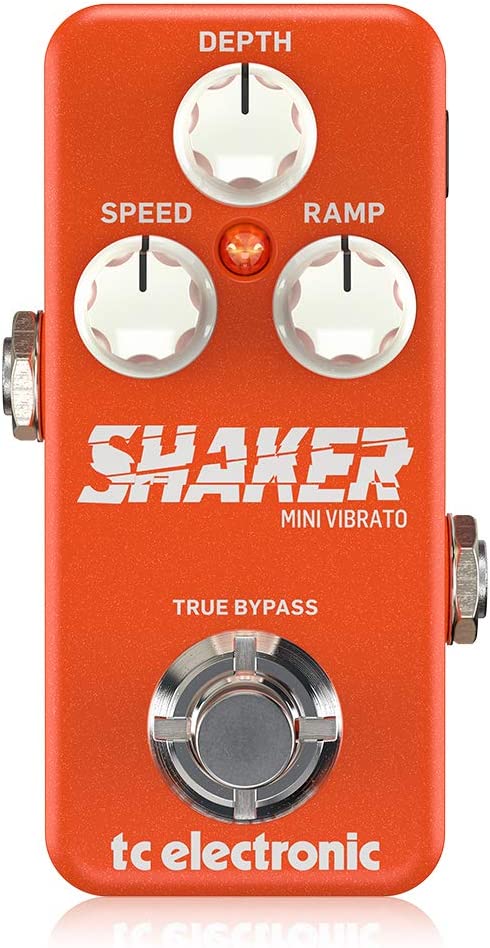
Meet the TC Electronic SHAKER MINI VIBRATO, a compact yet feature-packed vibrato pedal.
Equip your music toolbox with this beauty to take your creativity to the next level.
This sleek pedal comes equipped with TonePrint Technology, a feature that makes it versatile.
It allows downloading hundreds of effects without costing a penny – an undeniable win!
We can’t overlook its pioneering true bypass attribute, masterfully maintaining your tone’s integrity.
On a physical level, this petite device packs a punch with its compact size of 2.48 x 2.2 x 0.6 inches and a negligible weight of 3.65 pounds, making it an ideal addition to even the most crowded pedalboard.
With a 9-volt power supply, you can easily control its voltage.
Its distinctive ability to offer vibrant and varied vibrato sounds in such a small package sets this pedal apart.
Experience the unprecedented breadth of vibrato sounds with the SHAKER MINI VIBRATO.
- My Review
Upon exploration of the TC Electronic SHAKER MINI VIBRATO, immediately you’re struck by the compact size.
It demonstrates that power isn’t always dependent on size in stompboxes.
This pedal is a true testimony to that, packing within it features worth cherishing.
From the first touch, the mini vibrato pedal feels tangible, robust, and compact, something you can lug around without a second thought.
Its built-in TonePrint technology is commendable, providing an endless avenue for customization.
I could enjoy an array of downloadable, free effects that allowed me to sculpt my sound perfectly.
Calling it just versatile may be an understatement.
My tones remain crisp and undiluted, courtesy of its true bypass function, which impressively maintains tonal integrity.
The pitch variations embodied in this pedal are exceptional.
It has a predominant vibrato effect (contrasting tremolos) that slightly modulates the pitch, effectively creating rhythmic variations.
Its utility might not be required constantly, but it adds a flavor worth savoring, especially with electric guitars.
Using it with an overdriven sound generates intriguing results as well.
The latch position on the former, tastefully introducing a momentary effect, is quite handy, furnishing creativity with a unique touch.
I’ve also noticed that the footswitch might feel different, a bit stiffer than other pedal models, which may take some getting used to.
However, this pedal isn’t incredibly merciful towards batteries, it seems to consume them pretty quickly, even when not in use.
So, relying on a power supply might be the way forward.
To wrap it up, the Shaker Mini Vibrato brings a robust build, customizability with TonePrint, true bypass, and ease of use—in a compact package.
Despite minor power issues and the footswitch feel, I found it worth considering.
Here are the ratings I’ll give to the TC Electronic SHAKER Mini Vibrato Pedal:
It simultaneously caters to your need for vibrato depths while maintaining an uncompromised tone quality.
All this goodness packed in a pint-sized, roadworthy pedal piqued my interest.
- Pros:
- Small, sturdy, and portable.
- Versatile with built-in TonePrint technology.
- True bypass ensures tone preservation.
- Cons:
- Battery drains quickly if not unplugged.
- Footswitch harder compared to other models.
- Not suitable for constant use.
My final verdict is that the TC Electronic SHAKER MINI VIBRATO is a powerful, compact pedal brimming with features.
It blends versatility, superior tone quality, and commendable performance in a portable package.
Despite minor shortfalls in battery management and footswitch feel, its value as a compact, fully-customizable, tonally rich vibrato pedal is indisputable.
This pedal is a testament to TC Electronics’ innovative spirit and a valuable addition to any pedalboard.
Caline CP-506 Multimod Guitar Pedal
Caline CP-506 Multimod: 7 modulation modes, easy controls, rugged design.
The Caline Multimod features seven must-have modulation effects in one rugged enclosure. Get access to classic chorus, flanger, phaser, doubler, vibrato, tremolo, and pitch effects with 3 independent controls for a range of really useable tones. Easy to use and great value, this is a must-have pedal for any musician.
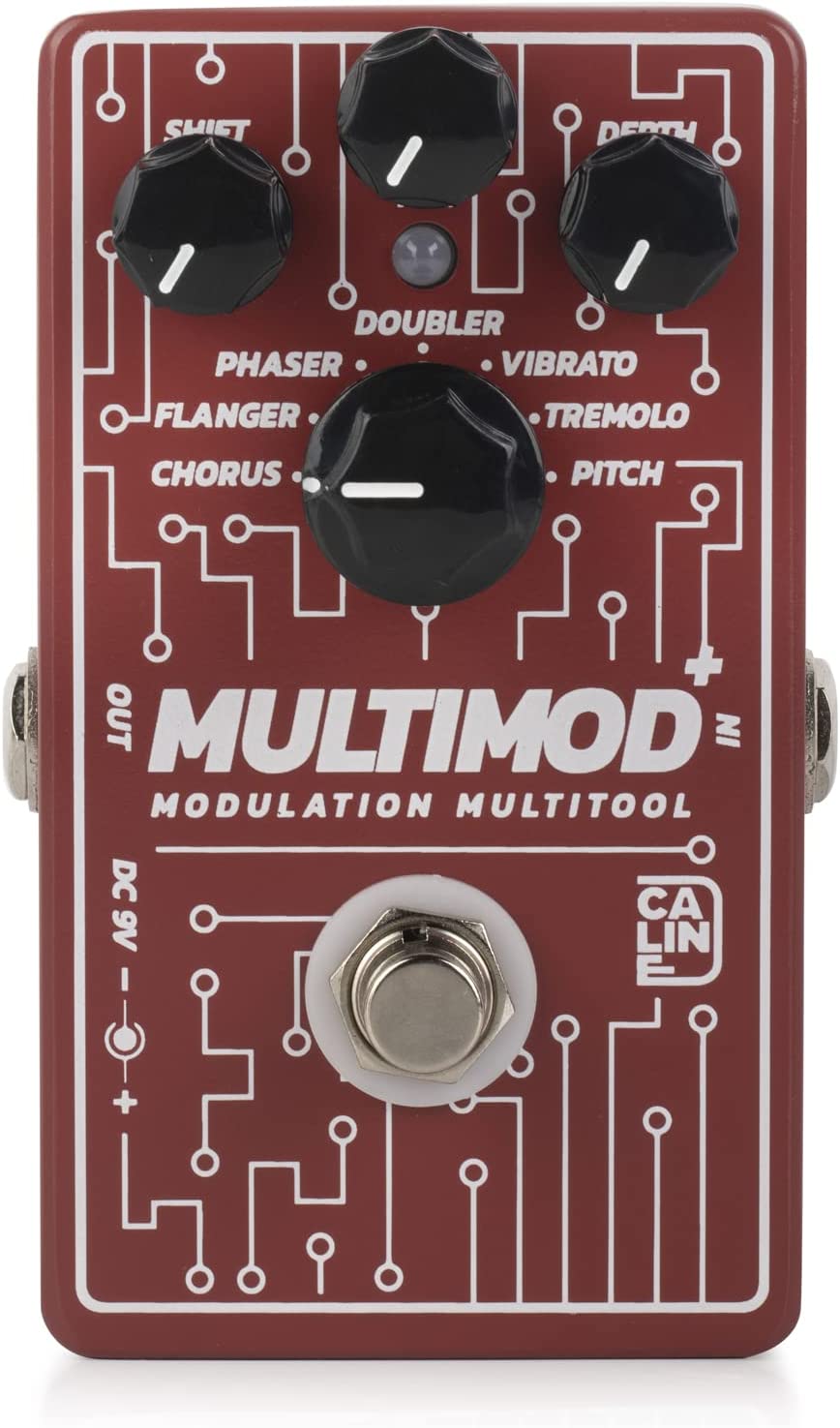
The Caline CP-506 Multimod is a versatile guitar effect pedal with various modulation parameters.
This compact device offers a fantastic range of seven modes: Chorus, Flanger, Phaser, Doubler, Vibrato, Tremolo, and Pitch.
Each option can be easily altered via three independent controls, allowing you to finetune your guitar’s tone as per your requirements.
The Multimod is compact, measuring 11.2 x 6.4 x 3.4 cm and only weighing 270g, which is great for musicians on the go.
Its durable aluminum alloy casing ensures it can withstand frequent usage.
This pedal offers a fantastic experience, although it needs a 9V center negative adapter not included in the package.
With the brand Caline behind it, you can expect quality and reliable performance from this multi-tool guitar effect pedal.
- My Review
Meeting me headfirst with its undeniable versatility was the Caline CP-506 Multimod, a multi-tool guitar pedal as intricate as it is efficient.
What initially drew my attention were the seven flavorful modes it offers; a sonic palette made of Chorus, Flanger, Phaser, Doubler, Vibrato, Tremolo, and Pitch.
Quite impressive!
The three independent control knobs on this unit – shift, depth, and mix – permitted me to explore and shape my tone with exceptional precision.
For instance, manipulating the shift knob gave me control over the speed of the effect, bringing a whole new dynamic range to my guitar sound.
The depth, however, lets me control the amount of modulation, introducing some beautiful flair to my tone.
Lightweight at only 270g and compact with dimensions of 11.2 x 6.4 x 3.4 cm, it is an easy pick for a musician on the go.
Plus, the sturdiness of the pedal’s aluminum alloy casing was a testament to its durability – perfect, I reckoned, to withstand the constant wear and tear of the road.
One slight niggle, I found is that the pedal doesn’t come with its own 9V center negative adapter, necessitating an additional purchase.
However, given the quality of the pedal’s performance, I’d say it’s a minor inconvenience and a solid investment.
Modulation up a notch was the Doubler effect, producing a lavish, fuller sound that surprised me.
In contrast, the Pitch added an intriguing overtone to my sound, differentiating this pedal from others I’ve tried.
There was a bit of a learning curve when it came to finessing the Pitch mode as a detuner.
Once I got it, though, it made a lovely, subtle difference.
Here are the ratings I’ll give to the Caline CP-506 Multimod Guitar Pedal:
In my experience, the Caline Multimod CP-506 is a robust modulation guitar pedal that doubles up as a reliable tool and a fun instrument to experiment with.
A solid blend of quality, versatility, and durability offers great value for its price.
- Pros:
- Seven versatile modulation effects.
- Independent controls for precision.
- Durable aluminum alloy casing.
- Cons:
- 9V center negative adapter not included.
- Some effects introduce noise.
- The Pitch mode is tricky to finesse.
My final verdict is that the Caline CP-506 Multimod is a high-performing, versatile guitar effect pedal that truly offers great value for its price.
Despite a couple of minor drawbacks, its overall performance, a solid range of features, and the ability to produce a variety of tones make it a worthy addition to any guitarist’s toolkit.
TC Electronic TAILSPIN Vibrato Pedal
Classic, all-analog vibrato tones with modern features.
TAILSPIN VIBRATO provides classic true-pitch vibrato tones with its all-analog, bucket-brigade design. The pedal has easy-to-use controls, sturdy metal chassis, and true bypass for ultimate usability. Get ready for endless waves of vintage vibrato pleasure!
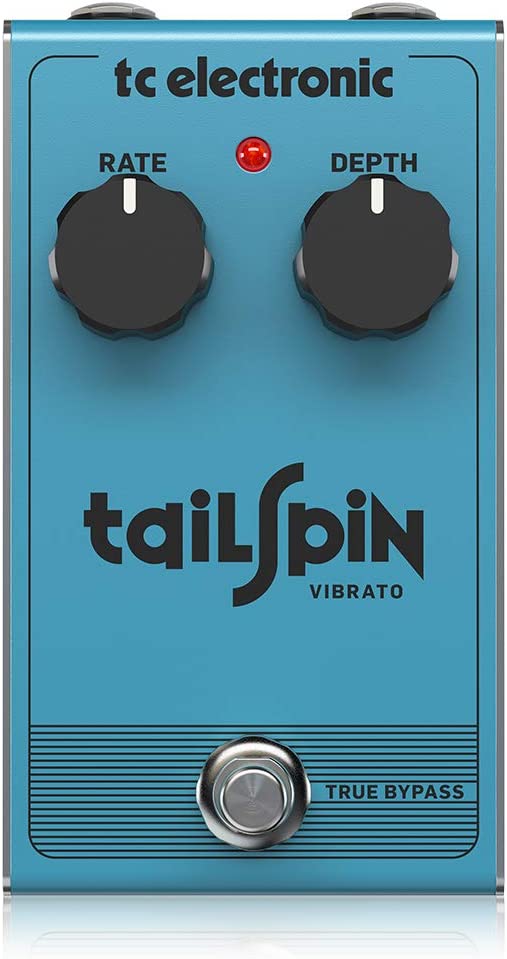
Have you heard of the TC Electronic TAILSPIN VIBRATO? It’s an amazing tool that can really take your music to the next level!
Inspired by the heyday of the 80s, its true pitch vibrato and legendary analog bucket-brigade (BBD) circuit tick all boxes for the classic vibe.
But where it stands out is the true bypass feature that assures the ultimate signal integrity.
Its robust metal chassis is built to withstand the rigors of a passionate performance.
It’s available in a fetching combination of teal and black, and the dimensions are 5.2 x 2.91 x 2.28 inches, with a manageable weight of 1.1 pounds.
Boasting a variety of sounds, you can create everything from subtle wobbles to rich, pitch-bendy vinyl tones, making it versatile for all musical contexts.
With user-friendly control layouts like Rate and Depth, setting up your desired vibrato effect is a breeze.
Use a 9V battery or a POWERPLUG 9V adapter to power up this marvel.
- My Review
Stepping onto the scene with an undeniable vintage charm is the TC Electronic TAILSPIN VIBRATO.
Packed with an analog bucket-brigade circuit, this pedal has my seal of approval for delivering a memorable true pitch vibrato.
As soon as I plugged in, the allure of the 80s was at my fingertips, instantly turning my guitar into a time machine.
What really stood out was the true bypass feature.
As soon as I stomped on the switch, I barely noticed any change in my signal.
Kudos to the TAILSPIN VIBRATO for holding the line and ensuring exceptional signal integrity.
This pedal does not shy away from a challenge.
Immediately noticeable was the robust chassis – just as promised, built like a tank.
It not only looks durable, but it surely can thrive in an active gig environment.
Its size caught the eye, quite bigger than it appears in photos but manageable nonetheless.
Getting the sound right was a breeze – TAILSPIN VIBRATO truly caters to any range of audibility.
Searching for a subtle wobble? It’s yours with a gentle turn of the Depth knob.
Craving something more daring, like pitch-bendy vinyl tones? Crank up that Rate and ride the wave.
Though if there’s a hiccup, it would be the absence of super slow speed vibrato.
Not a dealbreaker but a useful addition if an update ever comes knocking.
And while I was quite happy with the volume, adding a volume knob wouldn’t hurt.
The unique selling point, though, is undoubtedly the capability to recreate that organ-like sound.
Who needs a B3 organ when you can achieve near-identical effects by maxing out this relatively compact pedal?
Here are the ratings I’ll give to the TC Electronic TAILSPIN Vibrato Pedal:
Running on a 9V battery only adds convenience, but its compatibility with a POWERPLUG 9V adapter assures a consistent power supply.
The TAILSPIN VIBRATO is a versatile, functional, and reliable choice for anyone searching for that authentic vintage vibrato.
- Pros:
- Authentic vintage vibrato tone.
- Robust, roadworthy metal chassis.
- Friendly user-interface design.
- Cons:
- Lacks super slow vibrato speed.
- No volume control knob.
- Size can be bulky for some boards.
My final verdict is that the TC Electronic TAILSPIN VIBRATO is a solid, user-friendly, high-quality pedal that successfully captures the essence of vintage vibrato tones.
And while it does have minor limitations, it’s robust, roadworthy, and a great investment for any musician trying to add a slice of the 80s to their guitar sound.
FLAMMA FC05 Mini Modulation Pedal
Compact, durable, 11 effects modes for creative sound.
This FC05 Mini Modulation Pedal from Flamma features 4 control knobs and 11 effects modes, perfect for creating unique, custom sounds and adding new layers to your music. Its full metal body is lightweight and durable, making it suitable for gigs and transportation.
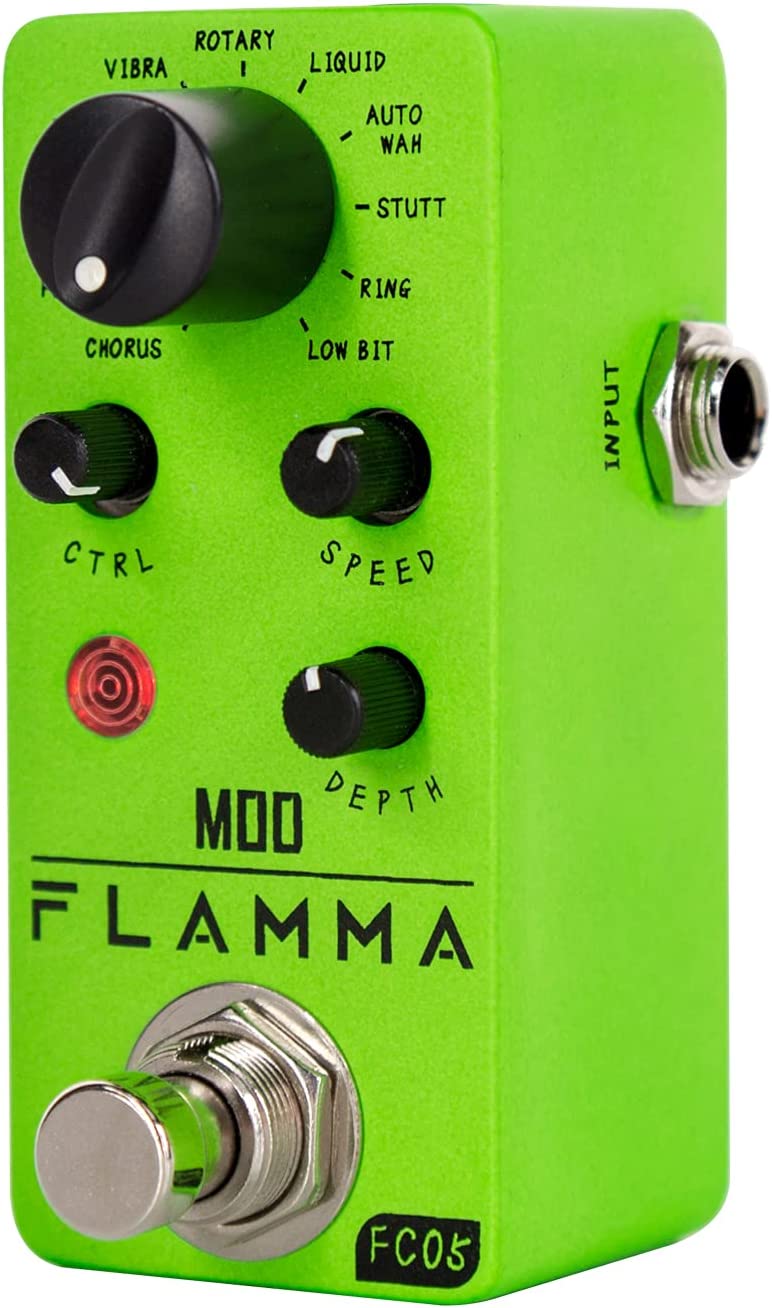
Step up your guitar performance with the versatile FLAMMA FC05 Mini Modulation Pedal.
This high-quality multifunction pedal has 11 unique modulation effects, including Chorus, Flanger, Tremolo, Phaser, Vibrato, Rotary, Liquid, Auto wah, Stutter, Ring, and Low bit.
Its compact design, full metal shell, and bright green color make it a durable yet stylish addition to any musician’s gear.
Furthermore, the pedal’s compact size ensures it’s easy to carry around, ideal for on-the-go musicians.
Its energy usage is minimal at just 9V, 150mA.
Comprehensive controls give you full authority over sound creation with four easily adjustable knobs.
The brand, FLAMMA, is renowned for offering advanced music technology that respects budget constraints while inspiring creativity.
With FLAMMA FC05, all levels of guitarists, from beginners to pros, get a host of sound manipulation and enhancement options in a portable and affordable package.
- My Review
Having immersed myself in the intricate dynamics of the FLAMMA FC05 Mini Modulation Pedal, its stellar features and impressive functionality quickly became apparent.
From the get-go, this is not your run-of-the-mill vibrato pedal.
With a whopping array of 11 classic modulation effects, it’s like a playground for sonic exploration.
Activating a Chorus, Flanger, or Tremolo is effortless, enabling the creation of immersive, textured soundscape guitars.
Portability and durability are key in the design of this pedal.
With a full metal shell, it readily withstands the rigors of constant gigging while its miniature form factor easily slips into any carry gear.
That bright green hue? It lends an energy punch, enhancing the pedal’s visual appeal.
Its power requirements are modest – a mere 9V, 150mA, adding to its overall efficiency.
But where this pedal truly shines, however, is in its control scheme.
With just four knobs, you can manipulate the modulation effect of your choosing, refining the CTRL, SPEED, and DEPTH to your satisfaction.
The indicator is a helpful guide, and the footswitch adds the convenience of a simple on/off toggle.
Yet I can’t gloss over the observed need to unplug and replug to power it back on.
The quirk feels uncharacteristic for a pedal of this caliber, although it’s curable with a straightforward tweak.
Additionally, I found a slightly high-pitched whine in some settings.
It wasn’t a deal-breaker, but it nudged me to play around with settings more to strike a clean balance.
Here are the ratings I’ll give to the FLAMMA FC05 Mini Modulation Pedal:
Still, the FLAMMA FC05’s comprehensive range and flexibility make it a robust tool for any guitarist’s pedal arsenal.
Despite minor quirks, its value proposition remains strong – its sound versatility, control intuitiveness, and portability provide a richness that’s hard to pass up.
- Pros:
- Offers 11 classic modulation effects.
- Compact, durable design with vibrant color.
- Value for money is substantial.
- Cons:
- Powering-on requires re-plugging.
- Some settings produce high-pitched whine.
- Performance has occasional quirks.
My final verdict is that the FLAMMA FC05 Mini Modulation Pedal is a powerful tool for guitarists seeking to explore a range of sounds and effects.
Despite a few quirks in its performance, this pedal’s top-notch versatility, features, solid tone quality, brand reputation, and substantial value for money make it an investment with rewarding returns.
It’s an impressive device that belongs to any passionate musician’s toolkit, fueling creativity and amplifying performance.
What exactly is a vibrato pedal?
A Vibrato Pedal is a device used by musicians, particularly guitarists, to modify the sound of their musical instrument to produce diverse tonal effects.
Vibrato, as a musical effect, is a regular pulsating change in the pitch of a note that adds expressiveness and texture to the music.
The term itself originates from an Italian term that stands for “vibrate.” A Vibrato Pedal makes it feasible for a musician to craft this effect simply by pressing it.
The pedal spruces the sound by fluctuating the pitch of the notes being played, creating a vibrating or oscillating effect.
It sequentially raises and lowers the pitch rapidly in a controlled manner.
This is distinct from tremolo, another sound modulation effect, which varies the volume rather than the pitch.
A simple way to remember this is: vibrato is to pitch what tremolo is to volume.
Now that we’ve established what a Vibrato Pedal does, it’s important to understand its components and how it functions.
The Vibrato Pedal is typically a compact, sturdy contraption with a footswitch constructed to withstand significant force.
There are also one or more knobs or sliders that allow the musician to regulate the parameters of the vibrato effect, such as depth, rate, and level.
Typically, these parameters function as follows:
Depth controls the extent of the pitch change.
Lower settings yield a more subtle vibrato effect, whereas higher settings produce a more extreme pitch fluctuation.
Rate regulates the speed at which the pitch fluctuates.
Slow settings can generate a wavy, psychedelic effect, while faster settings yield a nervous, jittery vibrato.
Level, where available, controls the overall volume of the effect, allowing for a balance between the vibrato effect and the original dry signal.

Some Vibrato Pedals also include more advanced options, like tone controls, waveform shape options, or a rise-time control that determines how quickly the selected settings take effect after the footswitch is engaged.
The interior of a Vibrato Pedal contains circuitry, which could be either analog or digital.
Analog vibrato pedals use a Bucket Brigade Device (BBD) circuit to achieve the vibrato sound.
It’s called bucket brigade because it moves the audio signal down a line of capacitors.
Just like a line of firefighters passing buckets of water, the signal is passed from one stage to the next, and at the end, it’s dumped to the output, having been delayed in the process.
Digital vibrato pedals use digital signal processing (DSP) chips to emulate the vibrato effect.
DSP can be more flexible and sometimes offers multiple types of vibrato in the same pedal.
Using a Vibrato Pedal can be shaped by a musician’s personal style and musical genre.
Some may employ the pedal subtly, creating a gentle, nearly undetectable fluctuation – often used in rock and blues.
Other genres, like jazz or psychedelic rock, may call for juicier settings that more obviously color the instrument’s tonality.
Some musicians may occasionally use a Vibrato Pedal to add flair to particular passages or for solo parts.
Others may leave the pedal on throughout their performance, creating a continuous unique sound.
As with most effect pedals, the best vibrato pedal for any musician is largely subjective and depends on the particular sound they are trying to achieve.
Some musicians may favor certain brands for their sturdy build, tonal quality, or the control range they allow over the vibrato effect.
Renowned brands that produce vibrato pedals include TC Electronic, Behringer, BOSS, and Dunlop.
The Vibrato Pedal merely serves to augment the musician’s toolbox of sounds.
Vibrato is an art that has evolved over the years, harnessing the intricate and unique beauty of pitch variation in music.
It’s a dash of sonic spice that, when used judiciously, can beautifully enhance the instrumental sound palette.
What should you consider when choosing a vibrato pedal?
There are many factors to consider when choosing a vibrato pedal for your guitar, from sound quality to the controls and features, from whether it is analog or digital to the build quality and durability.
Other factors may include presets and versatility, the brand’s reputation, your price range and budget, and the reviews and recommendations of others.
This article will delve deeply into each consideration, offering insights and advice to help you make the right choice for your music needs.
– Sound quality

Let’s start with perhaps the most critical consideration: the sound quality.
Remember, a vibrato pedal is used to modify your guitar’s tone, producing rhythmic pitch variations that produce a rich, vibratory sound.
Therefore, sound quality is paramount.
Some pedals produce a more dramatic and deeper vibrato effect, while others offer a mild and subtle touch.
You may prefer the former if you’re into blues or surf rock, while the latter may be more fitting for those who play indie, pop, or folk tunes.

The best vibrato pedal will provide a clean sound that won’t distort your instrument’s natural tone.
The effect’s depth, speed, and intensity should also be adjustable, allowing you to tweak to your preference.
– Controls and features

Regarding controls and features, vibrato pedals have a variety to offer.
The basic vibrato pedals generally have knobs for depth, speed, and rate.
Each of these knobs has unique functions that influence the sound produced by the pedal.
The depth knob, for instance, manages the intensity of the pitch shift, giving you control over how dramatic or subtle the vibrato effect is.
The speed knob, as the name suggests, determines the rate at which the vibrato effect oscillates, allowing you to dictate the speed of the pulsating effect.
Furthermore, the rate knob typically calibrates the vibrato waveform, establishing the pitch’s rhythmic variation.
These indispensable knobs make the basic pedals quite versatile.
However, advanced vibrato pedals come armed with additional features to cater to more nuanced needs and diverse playing styles.
Some of these pedals incorporate a chorus mode, which generates a rich, layered sound closely resembling the effect of multiple guitars playing in unison.
A tone control feature offers the flexibility to adjust the timbre of the sound, fine-tuning it to resonate better with your musical piece.
Another handy feature found in some advanced pedals is a built-in tuner.
This can be a lifesaver during live performances where tight schedules and quick gear switches demand prompt, accurate guitar tuning.
Pedals offering these additional features often come across as more enticing and beneficial to musicians who may prefer a specific playing style that these features cater to.
Yet, it’s vital to remember that features, especially advanced ones, come with a price.
Therefore, you need to warrant careful consideration to ensure that the added functionality brought in by these features contributes to your musical requirements, thereby justifying the higher price tag that usually comes with them.
– Analog vs.Digital

Vibrato pedals can either be analog or digital.
Both varieties have pros and cons; the best choice depends on your preference and playing style.
Analog vibrato pedals are often favored for their warm, vintage tone.
They usually have simpler controls, making them easier to use.
However, they lack the flexibility and versatility of digital pedals.

Digital vibrato pedals, on the other hand, offer a broader range of sound options and often come with preset options.
They are known for their clear, precise sound generation.
However, some purists believe that digital pedals lack the warmth and depth of analog pedals.
– Build quality and durability

In considering the build quality and durability of a vibrato pedal, it’s essential to remember that this piece of equipment will inevitably be exposed to heavy use.
Whether that’s being firmly pressed during intense gigs or pounding in a sweaty rehearsal room, these pedals are not pampered pieces of equipment.
Therefore, robust construction is necessary; it can’t simply be an afterthought.
An important consideration is the material the vibrato pedal is made from; ideally, you should look for one made of sturdy, resilient materials.
In most situations, this would mean opting for a pedal constructed of metal instead of plastic.
Metal tends to hold up better over time; it will be resistant to cracks, breaks, and other damage that might affect the performance and longevity of your pedal.
Besides the overall construction material, don’t overlook the importance of well-constructed switches and knobs.
These elements of your pedal will see a lot of use and, thus, require solid build quality.
When testing a pedal, these components should present a solid feel and provide a smooth, complete range of motion.
It’s worth noting that the perceived quality of the knobs and switches can often indicate the overall quality of the pedal.
If they feel flimsy, loose, or unstable, it’s a warning sign that the entire product may not stand up to long-term, repeated use.
High-quality components, well put together, are a sign of a pedal built to last, becoming a cherished part of your music-making for years to come.
– Presets and versatility

Presets and versatility can make or break a vibrato pedal’s suitability for different musical genres or personal playing styles.
A highly versatile pedal with an extensive range of tones, depths, and rates can provide you with a rich sonic palette to experiment with, adding a new dimension to your compositions or performances.
This range can prove exceedingly valuable if you are a versatile musician who enjoys experimenting across various musical styles or if your genre of choice demands a variety of tonal modulations.
A vibrato pedal with multiple preset options becomes an instrumental tool, especially when rapidly shifting between distinct sound profiles.
These preset and adjustable parameters give you the advantage of personalizing and fine-tuning your vibrato effect’s intensity, speed, and depth, thereby getting your desired sound with just a few knob twists.
Plus, imagine the convenience during live performances, where the ability to save your meticulously calibrated settings on your vibrato pedal can save you precious time and keep your momentum going.
Thus, the presets, and the sheer versatility of a vibrato pedal can exponentially enhance your musical expressiveness and performance fluidity.
– Brand reputation

The reputation of the brand is a significant factor to consider when choosing a vibrato pedal due to its direct influence on the quality and reliability of the product.
It’s worthwhile to seek out manufacturers known for consistently delivering well-constructed pedals, as this often equates to better performance and longevity.
These brands gained their reputations due to their sustained delivery of high-quality products.
Notably, among the plethora of pedal manufacturers today, there are substantial variations in reputation.
While opting for established brands with a proven track record might be comforting, one should not discount the potential of newer or relatively obscure brands.

These lesser-known companies can often offer innovative designs or exceptional value for money, akin to finding a diamond in the rough.
Consequently, though brand reputation is key, maintaining an open mind could sometimes lead you to discover unexpectedly outstanding vibrato pedals from brands you may not have initially considered.
– Price and budget

Vibrato pedals come in a wide range of prices, from budget-friendly options that cost around $50 to high-grade professional pedals that can set you back several hundred dollars.
Your budget is an integral factor in your decision.
However, rather than chasing the cheapest option, it might be better to consider the value for money.
Sometimes a slightly more expensive pedal might offer significantly better sound quality or durability, making it a more cost-effective choice in the long run.
– Reviews and recommendations

Last but not least, don’t forget to do your research.
Reviews and recommendations from fellow musicians can provide valuable insights into how a vibrato pedal performs in real-world situations.
These can often highlight strengths or weaknesses not apparent from the product specifications alone.
However, remember that reviews and recommendations are subjective.
A perfect pedal for one musician might not fit your playing style or preferences.
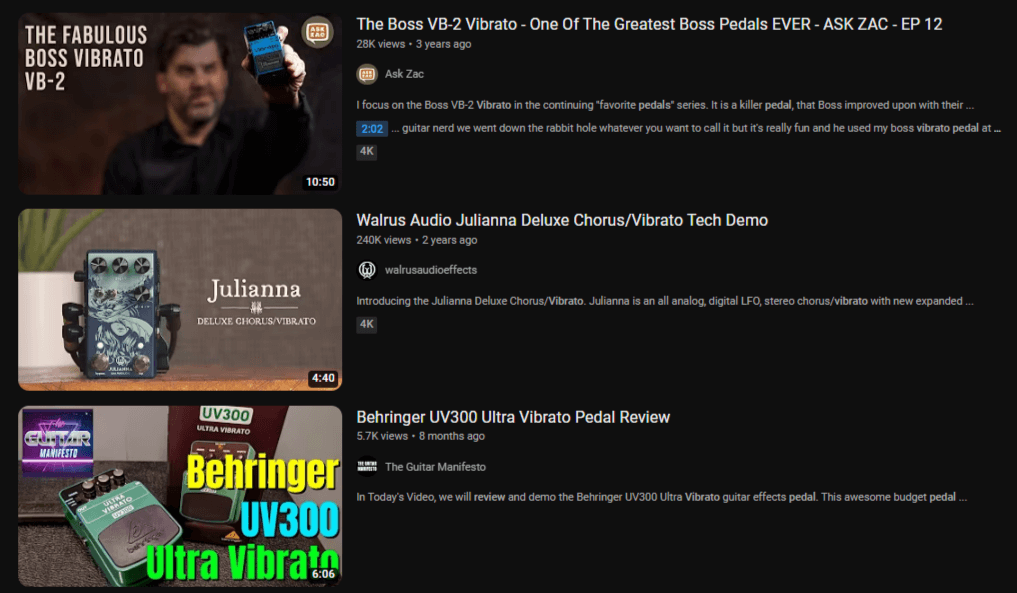
Use these reviews as a guide, but always make your decision based on your requirements and tastes.
YouTube is an excellent place to search for these reviews and recommendations.
How to properly use a vibrato pedal?
To maximize the potential of a vibrato pedal, discovering the right technique is crucial.
This guide will provide valuable tips and insights on properly utilizing a vibrato pedal to enhance your guitar playing with depth and expression.
– Familiarize yourself with the controls and features
The first crucial step to properly using a vibrato pedal is to familiarize yourself with its controls and features.
A vibrato pedal is a tool that imparts a wavering effect onto the tone of a guitar, and it accomplishes this through different knobs and switches that affect various aspects of the sound.
Common controls on a vibrato pedal include depth, rate, level, and tone knobs, and typically, some form of a switch to change the waveform of the vibrato effect.
The depth knob adjusts the intensity of the vibrato effect, while the rate knob alters the speed at which the note wavers.
The level or volume knob adjusts how loud the affected sound is about the clean, unaffected guitar tone.
The tone knob can shape the character of the vibrato by altering the treble, midrange, and bass frequencies.
Apart from the main control knobs, the waveform switch changes the modulation type, allowing waveforms like sine, square, and triangle.
You can also find additional features depending on the pedal model, like a ramp, latch, or un-latch switches, which control the onset of the vibrato effect or maintain the effect as long as the footswitch is pressed.
Take time to understand these various controls and their impact on your sound.
– Adjust the parameters to suit your musical goals
Every musician possesses a unique musical palette, and thus, it is imperative to adjust the parameters of the vibrato pedal to meet your particular musical goals.
If you desire a subtle, haunting vibrato for a blues song, adjust the depth knob to a lower setting and the rate knob to a moderate speed.
This allows for a passive, rolling vibrato effect — an ideal tonal blend for a deep blues piece.
For a vibrant rock sound, turn the depth and rate knobs up for an intense and rapid vibrato, forming a chunkier, grittier, more punchy effect.
If you’re playing a genre that calls for a mellow and smooth sound, like soul or R&B, dial in a slow rate and a medium depth — you’ll get a silky, dreamy vibrato.
– Incorporate the vibrato pedal into your signal chain
The placement of the vibrato pedal in your signal chain can significantly affect the overall output.
If you want a highly affected sound, place the pedal at the beginning of your signal chain.
Thus, all following pedals and effects will process the vibrato-induced sound.
But if you wish for a subtle vibrato application, place it toward the end of your signal chain so the vibrato processes an already colored tone.
– Experiment with layering sounds
A great way to add depth and complexity to your music is by layering the sounds produced through the vibrato pedal with other effects.
For instance, layering vibrato over an overdrive pedal could give you a thick, tape-like warp in your guitar tone reminiscent of vintage recordings.
Or combining vibrato with a touch of reverb might result in a spacey, ambient sonic imagery that lends your melody an ethereal quality.
Experiment with your pedals to find compelling combinations that enhance your musical creation.
– Adjust your playing technique
Using the vibrato pedal is not just about tweaking knobs and switches; it’s also about how you play the guitar.
For instance, use longer sustains or play chords instead of single notes if you want a long-lasting vibrato effect.
On the contrary, work with rapid staccato notes or quick strumming if you aim for a fluttering vibrato effect.
Challenging your playing techniques in alignment with pedal adjustments can create various unique and interesting sounds.
– Practice with different genres
Since vibrato is a universal musical ornament, practicing with different genres assists you in maximizing the pedal’s capacity.
Be it a wistful country ballad, a groovy funk piece, a fiery rock anthem, or eerily evocative ambient music, every genre provides a different setting to exploit the vibrato pedal.
Experimenting across genres will help you discover new tones, evoke different emotions, and widen your musical horizon.
– Record and review
Finally, recording and reviewing your performances is recommended to ensure you’re getting the most out of your vibrato pedal.
Recording yourself allows you to listen objectively to the sounds and effects produced and refine them.
It also lets you document your settings, so you can easily replicate a particular sound when needed.
Furthermore, remember that, like any other pedal, a vibrato effect is an accessory, not a crutch.
The vibrato pedal can amplify, shape and enhance your guitar skills, but becoming overly reliant on it may limit your ability to express musical thoughts and feelings.
Thus, practice and experiment using your vibrato pedal, but always prioritize music fundamentals and your unique artistic expression.
How to order pedals on a pedalboard?
There is no one-size-fits-all approach to ordering pedals on a pedalboard, as the optimal arrangement largely depends on the specific sound you’re aiming for.
Usually, though, you will see guitar players mostly agreeing with this order:
Tuner > Filters/Dynamics > Pitch-based Effects > Overdrive/Distortion > Modulation > Time-based Effects > Looper
Aside from that, some general guidelines can help you achieve a balanced and versatile setup.
Let’s talk in detail about the order we just mentioned, but feel free to experiment and adjust to your own preferences:
- Tuner: Place your tuner pedal first to ensure your signal is in tune before passing through the other pedals.
- Filters and dynamics: Wah-wah, envelope filters, compressors, EQs, and noise gates should come next. These pedals affect your sound’s dynamic and tonal aspects, so it’s best to place them early in the chain.
- Pitch-based effects: Octavers, harmonizers, and pitch shifters should come after filters and dynamics since these pedals alter the pitch of your signal and work best with a clean, unprocessed sound.
- Overdrive and distortion: Overdrive, distortion, and fuzz pedals typically come next. They shape your guitar’s core sound, and placing them before most other effects ensures that those effects receive a strong, consistent signal.
- Modulation effects: Chorus, flanger, phaser, and tremolo pedals should be placed after overdrive and distortion effects. We do this to allow these pedals to add depth and movement to your sound without becoming overly distorted or overbearing.
- Time-based effects: Delay and reverb pedals should be placed towards the end of your signal chain. This allows them to create a sense of space and depth around the other effects, simulating the sound of a room or hall.
- Looper: If you use a looper pedal, it should be placed last in the chain. This ensures that you’re looping the entire signal, including all the effects you’ve applied.
Remember, these are just general guidelines and what generally works and sounds good.
The most important thing is to experiment and find the arrangement that best suits your personal sound and style.
For example, here’s one pedalboard signal chain that I always use:
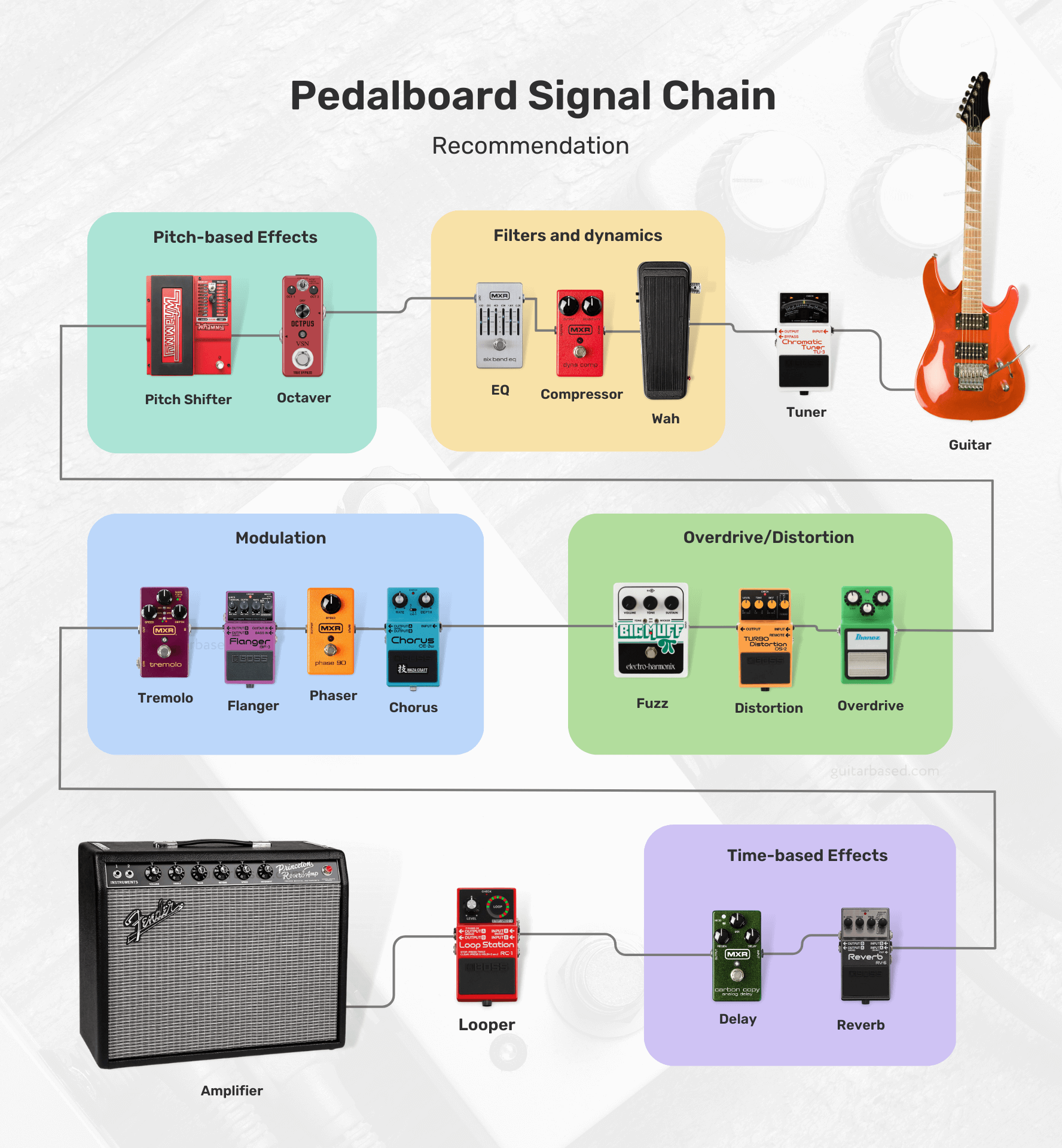
Feel free to swap the order of pedals, try different combinations, and test out unconventional setups until you find the one that works best for you.
For those interested, I’ll leave you with most of the possibilities that you’ll encounter and how to order them.
- Tuner
- Filters/Dynamics:
- Volume
- Wah
- Auto-Wah
- Compressor
- Noise Gate
- EQ (Equalizer)
- Pitch-based Effects:
- Octaver
- Harmonizer
- Pitch Shifter
- Overdrive/Distortion/Fuzz:
- Boost
- Overdrive
- Distortion
- Fuzz
- Modulation:
- Chorus
- Phaser
- Flanger
- Univibe
- Vibrato
- Tremolo
- Time-based Effects:
- Delay
- Echo
- Reverb
- Synth/Bitcrusher:
- Synth
- Bitcrusher
- Acoustic Simulator
- Multi-Effects
- Utility:
- Buffer
- A/B/Y Switcher
- MIDI Controllers
- Looper
Boutique vs. Mass-Produced pedals
Boutique pedals are generally built with higher-quality components and craftsmanship, resulting in better durability and longevity.
These pedals often feature unique and innovative designs, providing a wider range of tones and effects that may not be available in mass-produced options.
Here are a few examples of boutique pedals:

All the manufacturers also tend to have a more personal approach, with better customer service and the ability to customize pedals according to the user’s preferences.
However, boutique pedals are usually more expensive due to the smaller scale of production and the use of premium components.
Mass-produced pedals, on the other hand, are more affordable due to their larger scale of production and the use of cost-effective components.
These pedals are widely available and offer a range of popular effects, making them accessible to a larger audience.
Here are a few examples of mass-produced pedals:

The quality control for mass-produced pedals can vary depending on the brand and model, but many are reliable and offer good value for the money.
As for one of the downsides, you’ll find that mass-produced pedals may not have the same level of uniqueness or innovation as boutique options.
On the other hand, they may not provide the same level of customer service or customization options.
The choice between boutique and mass-produced pedals depends on your personal preferences, budget, and desired sound.
If you’re looking for unique tones, higher-quality components, and a more personal experience, boutique pedals may be the way to go.
But I would say, for those who are on a budget and need access to popular effects, mass-produced pedals might be a better fit.
It’s worth trying out both types to see which best suits your needs and playing style.
How much should you spend on a guitar pedal?
If I were in your position, I would first determine my budget and specific needs before deciding how much to spend on a guitar pedal.
For beginners, it might be more reasonable to start with affordable, mass-produced pedals to explore different effects without spending too much.
Guitar pedals can range in price from around $30 to over $400, depending on the brand, quality, and complexity of the effect.
As your skills and understanding of your preferred tone develop, you can gradually upgrade to higher-quality or boutique pedals.
One thing I would do is consider which effects are essential to your playing style and prioritize purchasing those first.
Allocating a larger portion of your budget to the most important pedals might be a wise choice, especially if you only need a few basic effects.
However, if you require a wide array of effects, you may want to consider more budget-friendly options or multi-effects units.
Keep in mind that higher-priced pedals often come with better build quality, unique features, and improved sound quality.
But I would also say that price is not always directly correlated with quality or suitability for your needs.
Sometimes, a more affordable pedal can deliver the exact sound you’re looking for, while a higher-priced option might not meet your expectations and are only expensive because of the brand reputation.
Can you use a guitar pedal with a bass guitar?
You can certainly use a guitar pedal with a bass guitar.
But it’s crucial to be aware that some guitar pedals may not be specifically designed to accommodate the frequency range of a bass guitar.
This could result in a less-than-ideal performance or an altered tone that might not be what you were expecting.
If you’re feeling adventurous and eager to experiment with your sound, don’t hesitate to connect your guitar pedals to your bass guitar.
This can be a fun way to explore different sonic possibilities, and you might even stumble upon some unique tones that complement your playing style perfectly.
Using a guitar pedal with a bass guitar may not always produce the desired results.
In some cases, the low-end frequencies might be lost, or the effect could sound too harsh or muddy.
To avoid these issues, you could consider looking into pedals that are specifically designed for bass guitars.
These pedals are engineered with the bass frequency range in mind, ensuring that your low-end remains intact and the effect sounds as intended.
In addition to bass-specific pedals, there are also multi-effects processors and pedals that cater to both guitar and bass players, offering a wide range of effects and tonal options.
These versatile units can be a great solution if you play both instruments and want a single device to cover your needs.
How to properly power your pedals?
When it comes to powering your pedals, you want to make sure you’re doing it right to avoid any noise issues or potential damage.
First, check each pedal’s power requirements, which you can usually find in the manual or on the pedal itself.
You’ll want to pay attention to the voltage (usually 9V, 12V, or 18V) and current (measured in milliamps or mA).
Now, you’ve got a few options for powering your pedals.
You can use individual power supplies or batteries for each pedal, but that can get messy and inconvenient.
I’d recommend going for a pedal power supply or an isolated power brick.

For example here are a few ones I recommend:
- Voodoo Lab Pedal Power 2 Plus Isolated Power Supply (My favorite)
- Rowin PW-1 Guitar Pedal Power Supply (Cheapest)
These babies can power multiple pedals at once, and the isolated outputs help prevent noise and ground loop issues.
Just make sure the power supply you choose can handle the voltage and current requirements of all your pedals.
When you’re connecting everything, use good quality power cables and keep them neat and tidy to avoid a tangled mess.
You might even want to use cable ties or cable organizers to keep everything in order.
In love with guitars, and gear; expert in all things music! Been writing about guitars for about 5 years and counting. Born in the ’90s. Alma Mater: University of Havana. Always curious, trying to understand the world. #TeamFender

